Why aren’t more Australians driving EVs?
Structured plan to help flatten aviation’s CO2 curve
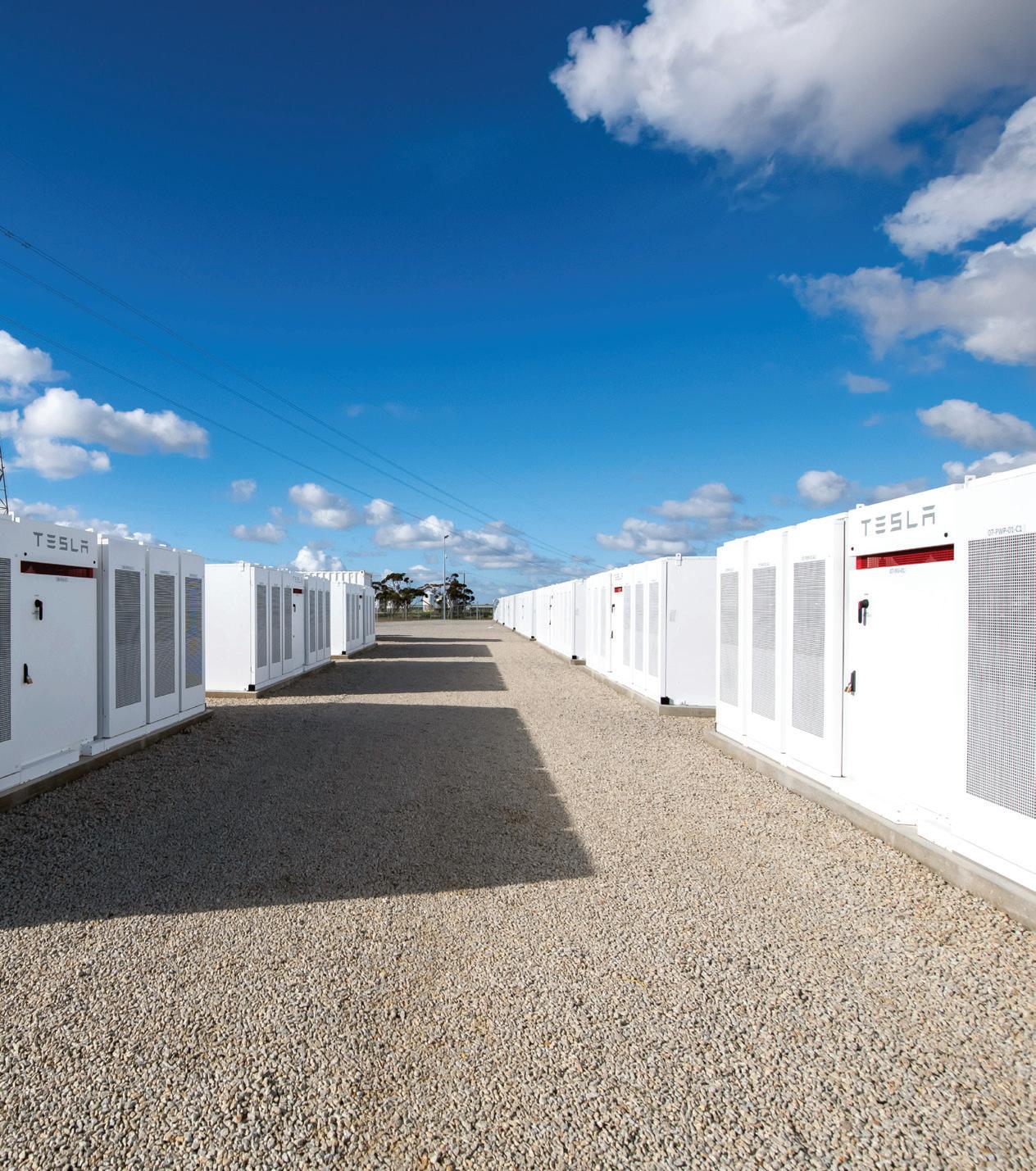
Batteries in the burbs: exploring the potential
Co-locating RENEWABLES AND BATTERIES: assessing the benefits
ISSUE 12 · November 2020 · www.energymagazine.com.au
Enterprise-Grade Internet & Phone for Remote Sites
Activ8me Business Services offers remote communications solutions for energy providers in remote Australia.
Solutions Available:
Unlimited data plans
Low contention rates
Fixed or portable hardware
Solar, self-sufficient options
Optional P2P, Extended Wi-Fi and Public Wi-Fi
Installation & Field Support Australia-wide
Our solutions overcome the limitations of integrating data-hungry applications, remote monitoring and M2M platforms into isolated operations.
No matter how harsh, remote or isolated the site, we’ve got a solution for you.
For enquiries contact our Corporate Sales team or visit: business.activ8me.net.au


Supporting 13 22 88 Contact Us Business Services


The Federal Government’s Budget for the 2020-21 financial year was handed down on October 6, and the energy industry gained an insight into how our future –at least in the short-term – will look.
The Government doubled down on its commitments to the gas industry, flagging that our recovery from the economic fallout from COVID-19 will be powered, largely, by gas.
This will perhaps be most keenly felt in the role gas will play in the $1.3 billion Modern Manufacturing Strategy, with it identified as the key energy source, and in some cases feedstock, to power our manufacturing goals.
Interestingly, the government also announced the creation of an inaugural National Gas Infrastructure Plan, which will identify priority infrastructure projects. It will also look at options to boost the Wallumbilla Hub into a more transparent Australian Gas Hub, like the Henry Hub in the United States.
In excellent news for the ongoing growth and development of our renewable energy sector, the Australian Renewable Energy Agency has been allocated $1.4 billion over the next ten years, ensuring its future for this period. The Clean Energy Finance Corporation was also handed new funding; and the government will expand the focus of both organisations so that they can invest in technologies to lower emissions outside of wind and solar.
Significant investments in transmission will also be made, with up to $250 million to accelerate major transmission projects such as Marinus Link, Project EnergyConnect and VNI West to the next stage.
In response, the Federal Opposition has argued that what the energy industry actually needs is a $20 billion plan to rewire the electricity grid, which it says is “desperately outdated”. Updating the transmission network would allow Australia to properly integrate the full capacity of the growing renewables sector and unlock its potential.
Given that there’s at least 18 months until the next federal election, the path that has been set for industry by the government is clear. What’s also now clear is a position from both of the major parties on where they believe the energy industry should be moving.
On the one hand we have investment in transmission, gas and renewables; and on the other, a play to “rewire the nation” to fully capitalise on the benefits of renewables. It’s a case of the slow and steady transition to renewables, versus rapid investment to bring the inevitable forward more quickly.
As an industry, we now know where the goalposts are. Our job, as we move forward into the COVID-safe, COVIDnormal world, will be to deliver the best outcomes within the framework that has been established for us. I know this industry is up to the task. Laura
1
Editor ISSUE 12—NOVEMBER 2020 WELCOME
www.energymagazine.com.au VERMEER CB6342 Co-locating RENEWABLES AND BATTERIES: assessing the benefits Why aren’t more Australians driving EVs? Batteries in the burbs: exploring the potential Structured plan to help flatten aviation’s CO2 curve Monkey Media Enterprises ABN: 36 426 734 954 204/23–25 Gipps St Collingwood VIC 3066 P: (03) 9988 4950
(03) 8456 6720
ISSN: 2209-0541 Published by We’re keen to hear your thoughts and feedback on this issue of Energy. Get in touch at info@energymagazine.com.au or feel free to give us a call on (03) 9988 4950. November 2020 ISSUE 12 Editor Laura Harvey Assistant Editor Imogen Hartmann Journalists Lauren Butler Eliza Booth Design Manager Alejandro Molano Designer Jacqueline Buckmaster National Media and Events Executives Rima Munafo Brett Thompson Marketing Associate Radhika Sud Marketing Assistant Stephanie Di Paola Publisher Chris Bland Cover image is of the Gannawarra Energy Storage System. In this issue of Energy, the operators of this system have shared some of their learnings from the first operational period for the GESS.
Harvey
EDITOR’S WELCOME
F:
monkeymedia.com.au info@monkeymedia.com.au energymagazine.com.au info@energymagazine.com.au






2 EMBEDDED NETWORKS 18 What the Victorian Default Offer means for the future of embedded networks 20 Energy disruption is here –but not as we expected GRID INTEGRATION AND STABILISATION 10 Maximising solar by rethinking PV panel orientation 14 Co-locating renewables and batteries: assessing the operational implications 18 10 RENEWABLES 22 Australia’s renewables journey: moving from fossil fuels to clean energy powerhouse 26 Federal Budget misses a trick, but states pick up the slack 28 Dealer reach means less downtime for Sequentia Services 30 Structured plan to help flatten aviation's CO2 curve 22 NEWS 4 What the budget means for energy 5 Funding changes for ARENA and CEFC 6 Australia-Germany hydrogen supply chain in the works 6 Former AGL exec to head up Tas Gas 7 Snowy 2.0 gets construction go-ahead 8 Australia’s first lithium-ion battery manufacturing facility EACH ISSUE 1 EDITOR'S WELCOME 64 FEATURES SCHEDULE 64 ADVERTISERS’ INDEX CONTENTS November 2020 ISSUE 12 www.energymagazine.com.au












CONTENTS 3 BIOFUELS 56 Harnessing the power of biosolids to make hydrogen 56 DEMAND MANAGEMENT 60 A proactive approach to managing large energy demands INDUSTRY NEWS 62 SA Power Networks wins 2020 Industry Innovation Award ELECTRIC VEHICLES 42 Queensland's Electric Super Highway takes shape 45 Why aren’t more Australians driving EVs? 48 Australia’s first electricpowered cherry-picker hits the streets 50 Electric vehicle subscriptions: the model for the future? 42 DEVELOPMENTS 52 The development approvals process: positioning your project for success 52 DISRUPTION 34 Batteries in the burbs: exploring the potential SWITCHGEAR 38 Safely grounded: timing measurements on gasinsulated switchgear EQUIPMENT 40 The products at the heart of critical infrastructure 34 62 60 www.energymagazine.com.au November 2020 ISSUE 12
WHAT THE BUDGET MEANS FOR ENERGY

The Federal Government has allocated almost $2.5 billion to the energy industry in the 2020-21 budget; with the gas sector flagged to play a pivotal role in Australia’s economic recovery from the COVID-19 pandemic.
Specific initiatives announced for the energy industry for the 2020-21 period include:
» Up to $250 million to accelerate major transmission projects such as Marinus Link, Project EnergyConnect and VNI West to the next stage. Together with existing support for HumeLink and the QNI Interconnector, this means all priority transmission projects are being accelerated, creating thousands of new jobs, putting downward pressure on prices and shoring up the reliability of the grid.
» A $53.6 million microgrid program to support the development of pilot projects in regional Australia, building on the success of the current Regional and Remote Communities Reliability Fund. This will help deliver more affordable reliable power in regional communities across Australia.
» Helping connect the North West Minerals Province (NWMP) near Mount Isa to the NEM through further support for the CopperString high voltage transmission line. This will allow major users in the NWMP to access reliable and more affordable energy supply, and encourage further investment in mining and processing in the region.
» $28.5 million to deliver cheap and reliable energy to Western Australians through the South West Interconnected System Big Battery project and a WA-based microgrids program for remote and indigenous communities.
» $52.2 million to improve energy efficiency, lower bills and deliver abatement, including $24 million to fund building upgrades and reduce energy costs for community groups and for small and medium hotels.
» $4.9 million over two years to improve cyber security in the energy sector and prepare government and industry for future threats.
The government is also strengthening Australia’s long-term fuel security through a $250.7 million investment in new diesel fuel
storage facilities and progressing reforms to boost the resilience of fuel supply and support local refineries.
Gas is set to play a huge role in the Federal Government’s economic recovery plans, with the announcement of an inaugural National Gas Infrastructure Plan (NGIP) to identify priority infrastructure projects, and options to boost the Wallumbilla Hub into a more transparent Australian Gas Hub, like the Henry Hub in the United States.
On top of the $42 million of investments to unlock supply, $10.9 million will be invested to strengthen gas infrastructure planning and deliver market reform to lower the price of gas for households and manufacturers.
The Federal Opposition responded to the Budget’s energy initiatives by outlining its own plan to invest $20 billion in rewiring the electricity grid, to allow Australia to adapt to changing energy markets and become a renewable superpower.
If elected, Labor would rewire the nation to drive down power prices, giving the economy a boost of up to $40 billion and creating thousands of new jobs – particularly in regional areas.
Australia should be a renewable energy superpower, according to the Labor Party, but the country’s electricity transmission system is “desperately outdated”. They argued that Australia’s transmission system doesn’t properly integrate the full capacity of the growing renewables sector, let alone unlock its potential.
Federal Labor Leader, Anthony Albanese, said, “Australia’s electricity network was designed for a different century, and transmission systems themselves are operated by monopoly providers who keep taking households and businesses for a ride.”
By establishing the Rewiring the Nation Corporation (RNC) and keeping it in public hands as a government-owned entity, Labor said it will ensure the grid is rebuilt at the best price possible.
The RNC would partner with industry and provide low cost finance to build the Integrated System Plan. The end result is expected to be cheaper electricity prices for homes and businesses.
Labor said it would ensure Australia’s modern energy grid would be built by Australian workers using Australian suppliers by mandating local supply and local labour.
NEWS 4 November 2020 ISSUE 12 www.energymagazine.com.au

FUNDING CHANGES FOR ARENA AND CEFC
The Australian Renewable Energy Agency (ARENA) and the Clean Energy Finance Corporation (CEFC) have received a funding boost of $1.9 billion from the Federal Government, ensuring their operation for the next decade.
Prime Minister Scott Morrison has also unveiled plans to introduce new legislation which would allow ARENA and the CEFC to invest in technologies to lower emissions outside of wind and solar, including carbon capture and storage, hydrogen, soil carbon, and green steel.
ARENA will be allowed to invest in renewable energy projects that are in the early stages of research and development while the CEFC is restricted to funding clean energy technologies that are in the commercial phase.
Mr Morrison said the $1.9 billion investment package in future technologies to lower emissions would back jobs, cut costs for households and improve the reliability of energy supply, however there is some concern from the industry that the new changes could potentially extend the life of coal-fired power plants.
“Australia is in the midst of a world-leading boom in renewable energy with over $30 billion invested since 2017. Solar panels and wind farms are now clearly commercially viable and have graduated from the need for government subsidies and the market has stepped up to invest,” the Prime Minister said.
“The government will now focus its efforts on the next challenge: unlocking new technologies across the economy to help drive down costs, create jobs, improve reliability and reduce emissions. This will support our traditional industries – manufacturing, agriculture, transport – while positioning our economy for the future.
“This will not only cut emissions, but deliver the reliable energy Australia needs while driving down prices for homes and businesses.”
The new package also invests in a range of low-emissions, reliable new technology advancements including:
» Supporting businesses in the agriculture, manufacturing, industrial and transport sectors to adopt technologies that increase productivity and reduce emissions through a new $95.4 million Technology Co-Investment Fund that was recommended by the King Review
» Piloting carbon capture projects with a $50 million investment in the Carbon Capture Use and Storage Development Fund
» Helping businesses and regional communities take advantage of opportunities offered by hydrogen, electric, and bio-fuelled vehicles with a new $74.5 million Future Fuels Fund
» Setting up a hydrogen export hub worth $70.2 million to scale-up demand
» Backing new microgrids in regional and remote communities to deliver affordable, reliable power with $67 million
» Contributing $52.2 million to increase the energy productivity of homes and businesses, including a sector specific grant program for hotels supporting equipment and facilities upgrades
» Slashing the time taken to develop new Emissions Reduction Fund (ERF) methods from 24 months or more to less than 12 months, involving industry in a co-design process and implementing other recommendations from the King Review into the ERF, worth $24.6 million
» Boosting energy and emissions data and cyber-security reporting and supporting the delivery of future Low Emissions Technology Statements under the Technology Investment Roadmap process, as well as developing an offshore clean energy project development framework, together worth $40.2 million
Minister for Energy and Emissions Reduction, Angus Taylor, said getting the next generation of energy technologies right would not only help to keep prices low and the lights on, but would grow jobs, strengthen the economy and reduce emissions.
“We will reduce the cost of new and emerging technologies, not raise the cost of existing technologies or layer in new costs to consumers and businesses through mandated targets or subsidies,” Mr Taylor said.
“The government recognises the strong growth in emerging energy technologies that will play a role in Australia’s energy mix into the future. We need to get the balance right and our investment to re-energise ARENA will deliver that.
The Federal Government said it will provide ARENA with guaranteed baseline funding of $1.43 billion over ten years.
ARENA CEO Darren Miller welcomed the new funding and an ongoing role for the agency.
“We are delighted to see ARENA’s important role acknowledged with new funding, and we welcome a new era for ARENA,” Mr Miller said.
“There is still much work to be done but with an experienced team, industry knowledge and strong networks across a range of technologies and sectors, ARENA is well positioned to support Australia’s energy transformation and emissions reduction goals.”
Over its lifetime, ARENA has helped to improve the competitiveness of renewable energy technologies such as large-scale solar, grid-scale batteries, pumped hydro, bioenergy, distributed energy technologies and hydrogen. Since 2012, ARENA has supported 543 projects with $1.58 billion of funding that has leveraged nearly $5 billion in additional private and public sector investment.
5 NEWS www.energymagazine.com.au November 2020 ISSUE 12
AUSTRALIA-GERMANY HYDROGEN SUPPLY CHAIN IN THE WORKS
Australia has signed an agreement with Germany initiating a joint feasibility study into the potential for hydrogen collaboration, including the future development of a hydrogen supply chain between the two countries.
Minister for Trade, Tourism and Investment, Simon Birmingham, said partnerships with countries such as Germany would be key to the development of a strong and worldleading hydrogen industry in Australia.
“These kinds of partnerships will be critical to further developing our emerging hydrogen industry and Australia’s future as a powerhouse in clean energy exports,” Mr Birmingham said.
“Exploring opportunities for future collaboration on commercial-scale operations, and investments in hydrogen production is vital if Australia is to realise the significant economic benefits and job creation opportunities hydrogen brings.
“This study gets the ball rolling on the development of a future hydrogen supply chain with Germany, which could lead to billions of dollars in export earnings for Australia and help them meet their future clean energy ambitions.
“With Australia well positioned to be a major supplier of low emissions hydrogen, and global demand for hydrogen continuing to grow, we need to continue to develop links with future importers around the world.”
Minister for Resources, Keith Pitt, said the study will look to underpin the future of hydrogen supply and help to inform two-way trade and investment between Australia and Germany.
“This kind of cooperation is another step in helping to secure Australia’s clean energy trading future which is backed by our abundant natural resources and strong history of being a reliable supplier,” Mr Pitt said.
“This agreement will open up another new market for our resources and potentially create thousands of new job opportunities for Australians well into the future.
“Clean hydrogen is a transformational fuel that can be used to power vehicles, generate heat and electricity, and as a chemical feedstock in major industrial applications.
“Australia has what it takes to be a world leader in hydrogen production and exports that will help our trading partners lower their emissions.”
FORMER AGL EXEC TO HEAD UP TAS GAS
Tas Gas has a new Chief Executive Officer, with former AGL executive Phaedra Deckart stepping into the role in October.
Ms Deckart had been a senior executive with AGL since 2015 and was part of the transformation of the company’s energy supply portfolio across gas, power, fuel and logistics, while navigating the transition to renewables across solar, wind and battery technology.
Ms Deckart has experience in the gas and energy sector having held various commercial positions at Santos across the domestic gas and global LNG market.
Ms Deckart said, “I am delighted to be joining Tas Gas, a business that has Tasmania at its heart, and provides gas distribution and gas supply to Tasmanians to heat their homes and provide energy to their businesses.
“It is a privilege to take up this role and ensure we continue to provide this essential service to customers and grow the business from its solid foundation.
“As we look to the future and to getting the Australian economy moving again, I believe the energy sector can play a key part in the recovery.”
Tas Gas Chair, Paul Adams, said the board was pleased to have appointed someone with Ms Deckart’s reputation and experience to lead Tas Gas through the next phase of its growth.
“We’re excited to have someone who has built such a strong reputation for advocating for the continuing role of gas as the natural partner in Australia’s energy transition and for providing a voice for the customers and communities that she’s served,” Mr Adams said.
Minister for Energy and Emissions Reduction, Angus Taylor, said collaborating with key partners such as Germany will help to drive down the cost of new hydrogen technologies.
“Australia has the natural competitive advantage to be a world leader in exporting hydrogen. The expertise and infrastructure from our gas industry will assist us to use hydrogen as an energy source at home,” Mr Taylor said.
“Australia’s future hydrogen industry has the potential to generate 7,600 new jobs by 2050, many in regional Australia, with exports estimated to be worth around $11 billion a year in additional GDP.
“This is why the Australian Government has committed more than $500 million to back this industry’s development.”
This partnership with Germany comes in addition to existing commitments Australia has already sought with other like-minded economies including Japan, South Korea and Singapore.
Information about the study and Australia’s hydrogen strategy is available on the Hydrogen Strategy website.
Australian research and industry partners can submit an Expression of Interest to the study at GrantConnect.

“We look forward to working with Phaedra and we are confident she will help to achieve the company’s full potential over the coming years.”
Mr Adams acknowledged departing CEO, Cameron Evans’, leadership through the sale of Tas Gas to Infrastructure Capital Group and through the challenging conditions during the pandemic in 2020.
Mr Evans has overseen a period of growth for the Tas Gas business, including the establishment of the business in Victoria through the Energy for the Regions Program, the integration of Gas Pipelines Victoria and the recent sale of Enwave.
Ms Deckart will continue to serve on the Australian Gas Industry Trust Board.
NEWS 6 November 2020 ISSUE 12 www.energymagazine.com.au
SNOWY 2.0 GETS CONSTRUCTION GO-AHEAD
The Federal Government has granted approval for Snowy Hydro to begin main works on its Snowy 2.0 project.
As the shareholder of Snowy Hydro Limited, the Federal Government’s approval for Snowy to commence main works follows final environmental regulatory approvals for the project in June 2020.
Future Generation Joint Venture, the main contractor building the project, will now begin construction of an underground power station, waterways and access tunnels, and other supporting infrastructure.
This builds on the exploratory works for Snowy 2.0, which commenced in 2019 and included constructing site access roads, excavating an exploratory tunnel and establishing a construction compound.
Former Finance Minister, Mathias Cormann, said that infrastructure projects like Snowy 2.0 will play a key role in Australia’s economic recovery from COVID-19 by creating jobs and boosting economic activity.
“More than 500 people and 100 local businesses have already been engaged on this project and we expect 5,000 direct and indirect jobs to be created over the life of the project, with the potential for many more jobs to be created locally and in the broader region through supply chains and support services,” Mr Cormann said.
“The economic benefits of Snowy 2.0 will have an enduring impact on the Snowy Mountains region, with the project providing opportunities for local businesses, improvements in local infrastructure and increased economic activity well into the future.”
Energy and Emissions Reduction Minister, Angus Taylor, said in addition to creating jobs and increasing economic activity in the region, Snowy 2.0 will drive down electricity prices across the National Electricity Market and deliver more reliable power.
“Snowy 2.0 is a defining project in our country’s history and forms a key part of the government’s agenda to deliver affordable and reliable power,” Mr Taylor said.
“The commencement of main works moves us a step closer to realising the benefits of Australia’s largest renewable energy project, the impact of which will be felt by millions of Australians.
“Those benefits are clear – affordable and reliable power across the National Electricity Market to ease pressure on Australian households and businesses.”
The Federal Government has committed up to $1.38 billion in equity for Snowy 2.0, with the remainder of the project to be financed by Snowy Hydro Limited.
Snowy 2.0 will provide an additional 2,000MW of fast-start, dispatchable energy and provide 350,000MW hours of large-scale storage, enough to power the equivalent of 500,000 homes for over a week during peak demand.
The project aims to reduce volatility in the market, support reliability and bring down power prices for Australian families and businesses.
Snowy Hydro Limited expects first power from Snowy 2.0 in 2025.

7 NEWS www.energymagazine.com.au November 2020 ISSUE 12
AUSTRALIA’S FIRST LITHIUM-ION BATTERY MANUFACTURING FACILITY
Lithium-ion battery manufacturer, Energy Renaissance, has announced the build of Renaissance One, a new $28 million battery manufacturing facility in Tomago, in the Hunter Region.
Mark Chilcote, Managing Director of Energy Renaissance, said, “We have settled on Tomago as the site of our first plant, construction will commence and the plant is scheduled for completion in 2021.”
Mr Chilcote said that the 4,000 sqm purpose-built facility will be constructed by local property developer ATB Morton and have an initial battery production capacity of 66MWh per annum, with plans to scale its Australian operation to 5.3GWh of energy storage per annum with an additional investment of more than $200 million.
“Over 1,700 direct jobs will be created during the construction and operational phase, and another 6,500 indirect jobs will be generated for the benefit of the Hunter,” Mr Chilcote said.
“The Hunter Region has all the right skills, natural resources, expertise and an abundance in solar energy for us to develop a successful battery manufacturing business in Australia.”
It’s expected that more than half of the batteries produced at Renaissance One will be exported through the Port of Newcastle.
The Federal Government provided a co-funded grant of $246,625 through the Advanced Manufacturing Growth Centre to Energy Renaissance. This has been used to accelerate research and development as it starts to manufacture batteries locally.
Patron Senator for the Hunter Region, Hollie Hughes, said, “Energy Renaissance will make clean and affordable energy more accessible and create greater energy security for Australia and our neighbouring countries.
“Once Renaissance One is operating at capacity, it will be able to provide – in the space of a year – enough batteries to power every public school, hospital, fire station, SES unit and new home built in Australia.
“That’s reassuring because Australia will be able to rely on its own source of renewable energy in the very near future.”
Ms Hughes said that the company’s investment in the local economy will support the Hunter region and help lead Australia’s economic recovery.
“I would like to encourage other manufacturers to move to the area to create a renewable energy manufacturing hub.
“With its deepwater port and proximity to the Newcastle University there is no better location for renewable energy manufacturers.”
Mr Chilcote said that building Renaissance One at Tomago will provide significant competitive advantages to Energy Renaissance.
“Access to the Port of Newcastle will allow us to ship our batteries to Southeast Asia while working with highly-skilled talent from CSIRO’s Energy Centre and graduates from the University of Newcastle,” Mr Chilcote said.
Dr Jens Goennemann, Managing Director of AMGC, said, “With its new site, Energy Renaissance will leverage Australia’s abundance of natural resources by adding value to raw materials, building onshore capability, and exporting into global markets.
“This in-turn will generate significant local manufacturing jobs and boost prosperity for the nation while giving Australia a significant foothold in the growing energy storage sector.”
The battery project aligns with the Federal Government’s Technology Investment Roadmap, which identified Australia as a potential world leader in the investment for renewable energy.
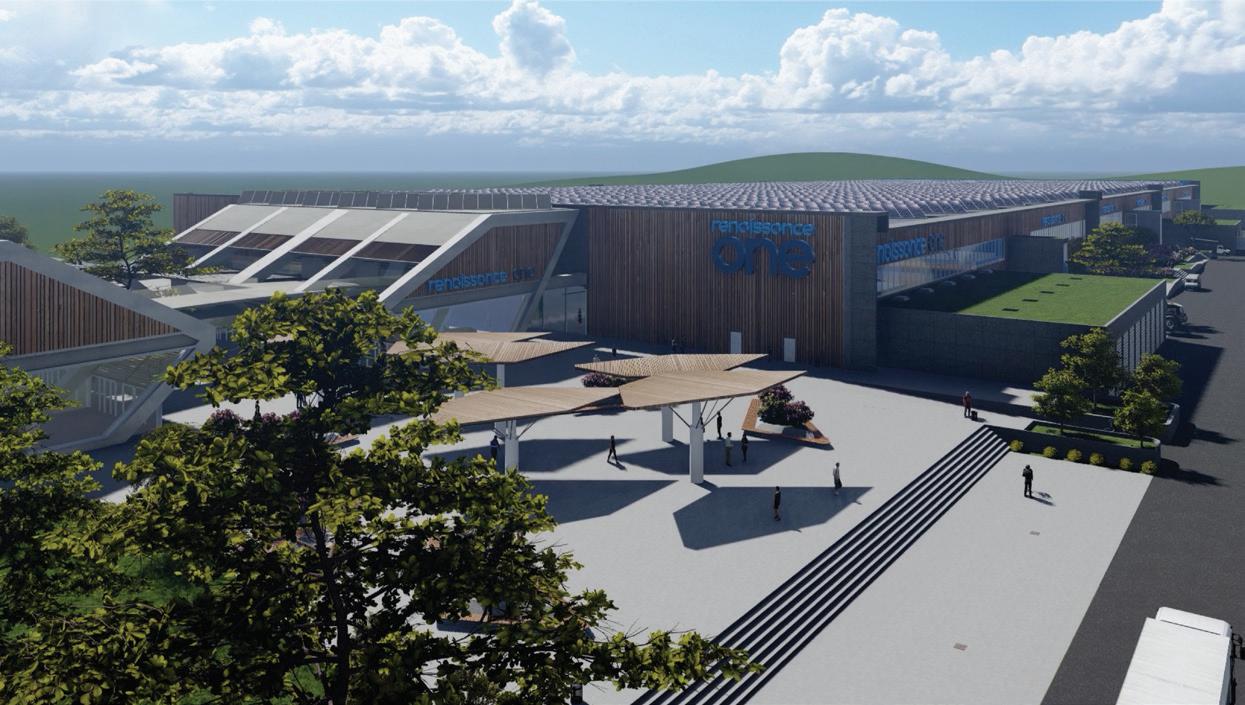
NEWS 8 November 2020 ISSUE 12 www.energymagazine.com.au
NER Chapter 7 compliant
3x Load Survey Files
Remote Disconnect
Demand Side Participation

AEMO Metrology Policy ready
Power of Choice (PoC) Energy Metering POWER OF CHOICE Flexible Metering Installations
Market Settlement Data (5-min, 15-min, 30-min)
Protocols: MV90, Modbus, JSON, IEC 60870
Dual Communications Options RS-485, 4G, Ethernet, WiFi, JSON
Another 1st by

RS00150AB
MAXIMISING SOLAR BY RETHINKING PV PANEL ORIENTATION
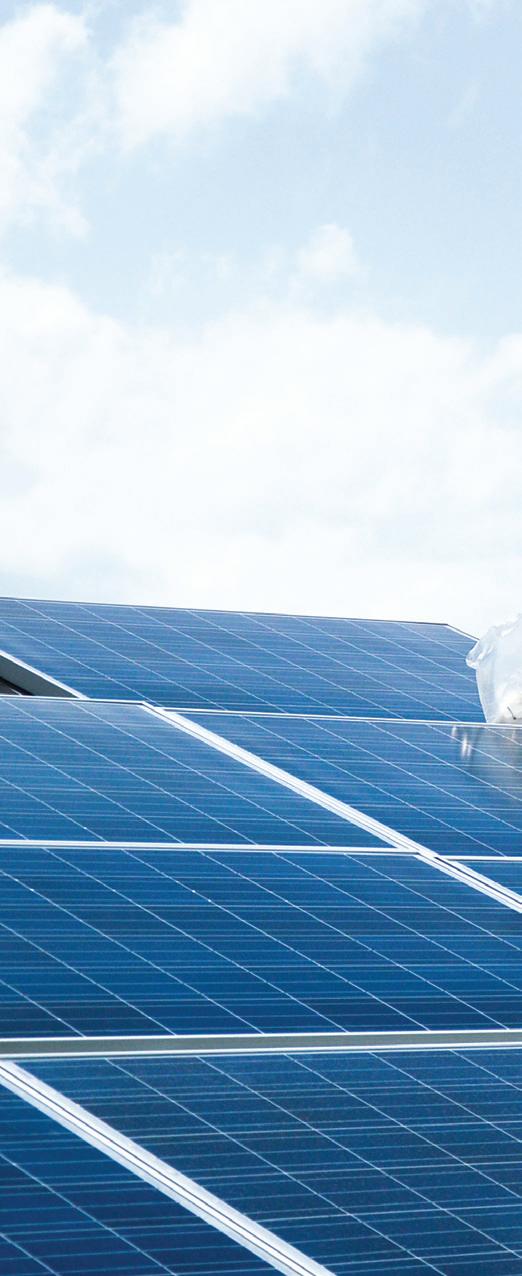
Traditionally, solar PV panels have been orientated in a northerly direction, towards the equator. But new research from the University of South Australia questions whether this is the most effective approach, particularly in a residential setting, where north-facing panels will produce the most energy in the middle of the day – outside the usual residential usage peaks.
Over two million Australian households – more than 20 per cent – now have rooftop PV solar panels, and while this is a generally positive scenario, the increased uptake of PV systems around the nation is creating a few challenges for our electricity industry.
UniSA solar researcher, Kirrilie Rowe, said one key problem currently facing home PV stems from the discrepancy between the times of peak use and peak production.
“Solar panels on residential dwellings are typically installed facing the equator
10 www.energymagazine.com.au GRID INTEGRATION AND STABILISATION
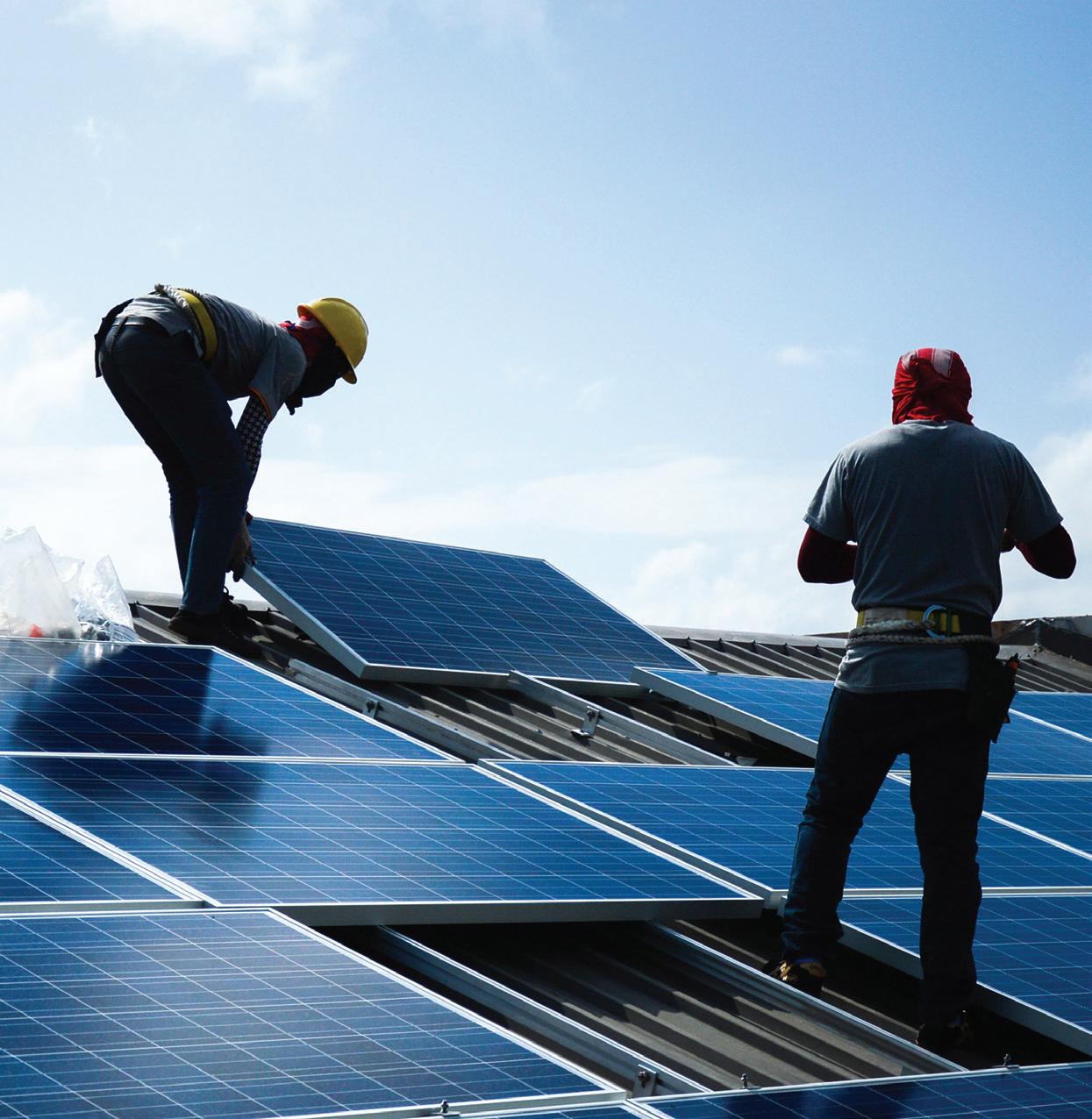
to maximise the energy collected, but the power generated by an equator-facing panel peaks at around midday, whereas residential loads typically have peaks in the morning and afternoon,” said Ms Rowe.
At the moment, households are paid a feed-in tariff for excess electricity they send to the grid, but, as the number of homes producing electricity increases, the viability of exporting to the grid is reduced.
“In some markets at certain times we’re already seeing over-supply during peak production times, which can cause grid instability and is leading to reduction in feed-in tariffs,” said Ms Rowe.
“The real challenge now facing the solar industry is finding ways to balance production and consumption by maximising self-consumption for the solar panel owner.”
Offering one elegantly simple solution to this challenge, Ms Rowe’s research explores how rethinking the orientation of rooftop solar panels might better match times of production to patterns of consumption, even if that means a slight reduction in overall energy generation.
“Traditionally, PV panels are mounted facing the equator as this creates more energy per square metre of PV panels, but this orientation does not necessarily
maximise the community self-use of the energy prior to the excess being exported to the wider grid,” said Ms Rowe.
“By orienting panels in different directions rather than just facing the equator, it’s possible to minimise the shortfall between load and generation for a community precinct.
“This benefits the end-user by decreasing the amount of electricity required to be imported, and the stability of the grid by decreasing the amount of variability between peak and low loads.”
A recent study by Ms Rowe and Associate Professor Peter Pudney
11 www.energymagazine.com.au November 2020 ISSUE 12 GRID INTEGRATION AND STABILISATION
calculated the optimal panel orientation for self-consumption for a community of 29 individual dwellings and a residential building with 42 apartments in Australia.
The individual dwellings form a residential development at Lochiel Park, South Australia, designed by the South Australian Government to be a ‘model green village’, with every house having a minimum 7.5-star NatHERS rating. The electricity use of each property is recorded every minute, and this data was aggregated to provide 30-minute samples for Ms Rowe and Associate Professor Pudney’s research, with data from two separate years (2015 and 2017) compared.
The apartment data for the research came from an inner northern suburb of Adelaide, the location of the state's first higher density urban infill project. All buildings meet 5-star Green Star As Built standards, a sustainability rating system launched in 2003. Hourly energy use data from a block of 42 apartments was used, from years 2016 and 2017.
Neither the individual nor apartment dwellings are organised as embedded networks, but the load data was aggregated as if they were.
“Our analysis uses detailed load data and detailed irradiance data, and shows that optimal panel placement for self-consumption is only towards the equator when the area of PV panels is small,” said Ms Rowe.
“In all cases, if the panel area is small enough so that the household will not export, then facing the panel north is best. But as panel area increases, it becomes better to face the panels north-west to meet the afternoon loads, and if even more panel area is available, then panels should be faced north-east and west.”
By placing panels more north-east and north-west, the load in the middle of the day was still met, but a greater proportion of the morning and afternoon load was also addressed.
For precincts made up of either the individual dwellings or the apartments, panels oriented north gave the greatest initial reduction in the shortfall between generation and load when PV area was below around seven square metres per dwelling, which currently equates to around a 1.4kW array.
For total panel areas beyond this size, panels were never oriented north.
Over the next few years, as solar uptake increases, feed-in tariffs fall and the cost of solar batteries remains prohibitive, the real value of solar self-consumption will continue to rise. Initially, government subsidies such as generous feed-in tariffs were required to encourage the uptake of rooftop solar, but these subsidies are now decreasing or disappearing altogether.
However, Ms Rowe believes that, as feed-in tariffs diminish, rooftop solar can remain cost effective as long as the local generation is self-consumed.
“Future electricity tariffs are likely to be structured to try to limit electricity use during periods of high demand and encourage use during periods of low demand, by imposing high import costs during periods of high demand and low import costs during periods of low demand,” said Ms Rowe.
“Where feed-in prices are still available, export prices are usually significantly lower than import costs. Orienting photovoltaic panels to best match the load results in less energy imported from the grid during the morning and afternoon peak demand periods, which generally will result in a more cost-effective renewable energy system than if panels were placed north.”
Long-term growth in energy demand from the grid, or increases in peak power demand from the grid, may also increase the price of grid electricity due to the necessity for grid augmentation. Structuring residential communities such that they slow the rate of increase in peak power demand will also tend to lower the cost of electricity over the longer term.
The strategy developed by Ms Rowe and Associate Professor Pudney offers a simple approach to improving self-consumption in precincts without increasing set-up costs on new PV systems, and the method could also be easily adopted for remodelling existing systems.
“The information on how to orient solar panels to minimise power shortfall is useful to groups developing housing precincts, and has been used to design a renewable energy system for a retirement village with 24 dwellings,” said Ms Rowe.
“Future work will incorporate energy storage into the model,” she added.

12 November 2020 ISSUE 12 www.energymagazine.com.au
INTEGRATION AND STABILISATION
GRID

“Run with us – Your partner in Plastics”






All Australian Supplied Electrical Cable Cover is manufactured in accordance with AS4702-2000 and is independently tested, by TUV Rheinland Australia
Unique rounded edging of the Cable Cover ensures maximum installer safety and reduces the risk of injury
100% Recycled Plastic
Notched Pallet allows web hoist to be safely fed through the coil and ensure safe offloading of larger coils
Gas Protection Covers available in a range of sizes
The Corrugated Cable Cover, is a patented product, manufactured under License
Thicknesses range from 3mm to 10mm, Widths available from 100mm up to 600mm
Standard Slab Length available in 1.2, and 2.1 Metre
Standard Coil Lengths are 10 Metre, 15 Metre, 20 Metre, 25 Metre and 150 Metre
Both Plastics Extrusions Thailand, and AGC Plastics, are 100% Australian owned and ISO accredited Companies
The product is continuously checked during the production cycle to ensure the surface finish, size, weight and impact strength are to the required specification
In-Line Printing allows for product batch and manufacture date for identification and tracing
Maintain strict control over all our procedures so as to maintain the highest quality of both product, and service to our customers

+61 432006775 rory@agcplastics.com.au
for
Contact Rory Livingston AGC Plastics Pty Ltd 38 Sarton Road, Clayton Victoria, 3168 Australia www.agcplastics.com.au AGC Plastics has a number of quality distributors in Australia, as well as internationally. Please contact us
further information.
ELECTRICAL CABLE COVER
AS4702-2000
CO-LOCATING RENEWABLES AND BATTERIES: ASSESSING THE OPERATIONAL IMPLICATIONS
by Andrew Stiel, Energy Markets and Offtake, Edify Energy

Edify Energy, with support from EnergyAustralia, recently published a knowledge sharing report covering the first 12 months of operations for the Gannawarra Energy Storage System –a 25MW/50MWh lithium-ion battery that shares connection infrastructure with the 50MW Gannawarra Solar Farm. Here, we explore some of the learnings from this first operational period and provide insights into how this may drive development decisions for future battery systems seeking to support renewables and advance the transition to a sustainable energy sector.
14 GRID INTEGRATION AND STABILISATION
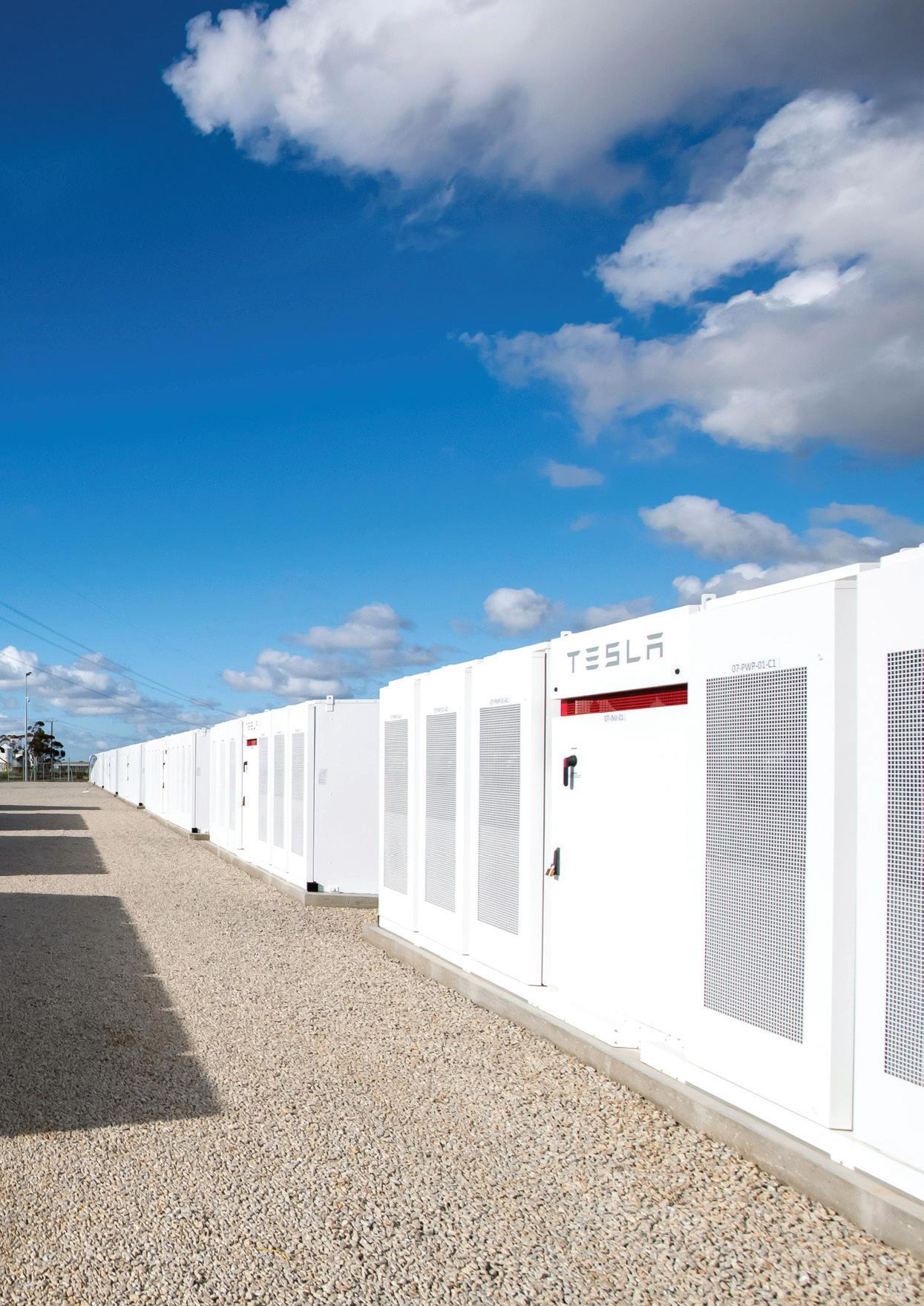
15 GRID INTEGRATION AND STABILISATION

If investment in the National Electricity Market (NEM) in the last few years has taught us anything, it is that there needs to be a renewed focus on energy projects premised on the potential to both create value and mitigate risk (technical, market and operational), rather than being solely driven toward the lowest levelised cost of energy. The coordinated investment of batteries and renewables is a potential pathway to realise value creation and risk mitigation, and one that is consistent with the findings of the most recent Integrated System Plan from the Australian Energy Market Operator (AEMO).
The inclusion of batteries in the business case for renewable projects has a number of advantages, such as diversification of revenue streams (for example, energy markets and frequency control ancillary services) and mitigating market risks such as increasingly shallow prices during daylight hours for solar. What is not clear however, is the deployment model to access these advantages. In particular, the question on whether to co-locate the renewable and battery facility behind common network infrastructure or to establish each facility on a stand-alone basis does not always have an obvious answer.
The principal feature that distinguishes the Gannawarra Energy Storage System (GESS) from other operational batteries in the NEM is the fact that it shares network connection infrastructure with the Gannawarra Solar Farm (GSF). The obvious benefit of such an arrangement is that it allows for greater utilisation of
costly network infrastructure. The drawback is that, depending on the relative size of the network infrastructure, this sharing could introduce an export constraint for the combined facility. In the case of the 25MW GESS and 50MW GSF, a combined 50MW export limit exists. However, this export limit only serves as a constraint to the extent it prevents access to commercial opportunities for either project; something that can be assessed by viewing the first 12 months of GESS’s operations.
Does shared network infrastructure constrain co-located battery operations?
The role that batteries have been playing in energy and frequency control ancillary services (FCAS) markets in the NEM is already widely reported on. Consistent with other batteries, the predominant source of revenues in the first 12 months of GESS’s operation was from FCAS, not the time shifting of energy. For the most part, the 50MW export constraint did not place a significant commercial limitation on the operation of GESS and its access to energy and FCAS market opportunities. The observed dispatch profile of GESS closely tracks that of prices (that is, dispatching in mornings and evening peaks); a trend that is anticipated to continue as increased solar uptake continues to depress prices during daylight hours. This brief period of operation of GESS therefore highlights the complementary nature of solar (if not wind) and batteries, with batteries serving to mitigate the downside
16 November 2020 ISSUE 12 www.energymagazine.com.au GRID INTEGRATION AND STABILISATION
Edify Energy has published a knowledge sharing report which covers the first 12 months of operation of the Gannawarra Energy Storage System.

market price risks of correlated solar in a way that is not overly burdened by the physical constraints introduced by common network infrastructure.
That said, there were inevitably occasions (including some high price periods) where the 50MW export constraint of the combined facility did introduce a commercial limitation on GESS’s operation. During these periods, it was demonstrated that having access to an accurate solar forecasting system and a high degree of coordination between this telemetry and the trading floor is important to limit lost value that could otherwise be captured with greater confidence in the solar output. This effect can be most pronounced in the morning and evening ramp up and down periods, during which solar output is harder to forecast and which also coincide with the end and beginning of price peaks.
Another distinguishing feature of GESS is that network tariffs are incurred when drawing a load through Powercor’s 66kV distribution network; a position that is inconsistent with Transmission Network Service Provider approaches (and is currently subject to standardisation via rule change processes). The management of GESS’s state of charge therefore needs to account for these
tariffs. The presence of GSF however creates an opportunity to avoid these network tariffs, where charging during solar hours would not place a load on Powercor’s 66kV network. This option is not available to a stand-alone battery solution connected to a distribution network, which in all instances would face network tariffs when performing a charge.
Could reform expand the value creation and risk mitigation options?
In addition to making greater utilisation of network infrastructure, the co-location of batteries and renewables should also be capable of accessing further integration benefits, which are not accessible today, but could be proposed as part of current market design reform efforts.
These include, but are not limited to:
» Using the battery to make real-time adjustments in output (i.e. depart from its scheduled position) in response to the renewable generator’s fluctuating generation to permit selfperformance of regulation services and bring causer pays FCAS relief to the renewable generator; a material operational cost and risk that cannot be directly hedged today. This is in contrast to classifying the combined facility as a scheduled generator (recognising the potential capacity and energy limitations of the battery in managing a scheduled position) or providing concurrent regulation FCAS from the battery, which is not a perfect hedge to this exposure.
» Constraint relief, whereby a load created by the co-located battery permits greater output from the renewable generator during periods of network constraints. The objective here should be to permit coordination in dispatch so that it is only the co-located renewable generator that is the beneficiary of this load, and no free-rider situation is created to the benefit of other generators behind the constraint. This would serve to address a material operational risk facing many renewable generators and improve the commercial case and utility of batteries. It has application to both existing generators looking for options to mitigate new constraints, and projects in development looking to mitigate expected constraints.
» Improved compliance against aspects of Generator Performance Standards, such as using the technical properties of the battery system to meet Continuous Uninterrupted Operation (CUO) requirements or provide a degree of system strength remediation. Generators today carry significant technical compliance obligations but are not always empowered to manage them. Expanding the technical options available for generators to meet compliance obligations with co-located battery systems should benefit developers and the stability of the system alike.
With recent statements from Canberra in support of gas as a transition fuel at odds with findings in AEMO’s ISP, which view of the future ultimately proves correct will largely be determined by investors in the energy sector.
Observing and learning from early battery projects is important to inform developers and investors to ensure the optimal and correct decisions are taken.
We at Edify see the growing coordination between renewables and batteries as an inevitable eventuality as the sector strives for a sustainable, low-cost and stable system. We’ll continue to play a leading role in driving toward optimal outcomes for investors, consumers and the energy system. The future is now. There is no time to waste.
17 www.energymagazine.com.au November 2020 ISSUE 12 GRID INTEGRATION AND STABILISATION
The Gannawarra Energy Storage System knowledge sharing report for the first 12 months of operation can be found at www.edifyenergy.com
WHAT THE VICTORIAN DEFAULT OFFER MEANS FOR THE FUTURE OF EMBEDDED NETWORKS
With many Victorians doing it tough this year, cheaper prices for utilities is always welcome news. In July 2020, the Victorian Government announced new pricing reforms that would place pricing caps on electricity for Victorians living in embedded networks. We take a closer look at the Victorian Default Offer, what it means for customers and what it means for electricity businesses.
What is the Victorian Default Offer?
The reforms announced in July were part of a series of reforms to improve energy prices and transparency across the Victorian energy market. These reforms resulted in the Victorian Default Offer (VDO) being implemented, which imposed pricing caps on standing offers, meaning that retailers cannot charge over these set prices.
The VDO is part of the Victorian Government’s Energy Fairness Plan which is making the electricity market fairer, simpler and more affordable for all customers. It was introduced after an independent review found that Victorians were paying too much for their energy needs.
In September, the VDO was extended to include customers in embedded networks, which are electricity networks that are privately owned and managed, and supply electricity to a specific building or area, such as apartment buildings, caravan parks, retirement villages and small businesses.
According to the Essential Service Commission (ESC), the extended VDO reforms will benefit over 104,000 Victorian customers in embedded networks.
It’s estimated that with the new pricing caps in place, residents of apartment buildings, caravan parks and retirement villages could save between $180 and $370 a year on energy bills, while small
businesses in shopping centres could save between $900 and $2,200, helping both individuals and businesses during one of the toughest times in Australia.
Phil Baxter, Chief Executive Officer of embedded network provider WINconnect, said that there were multiple reasons for price increases for Victorian customers over the past few years, including the closure of key infrastructure, as well as a lack of retail competitiveness.
“There are many reasons why power prices have escalated over the past five years. The major driver has been on the supply-side, where generation disruption such as the closure of the Hazelwood Power Station – previously one of Victoria’s largest generators –alongside significant investment in poles and wires infrastructure, have contributed to bill increases,” said Mr Baxter.
“But there have also been issues relating to retail failures whereby non-engaged customers receive unfair prices when their conditional discount agreement ends, as well as issues relating to a lack of a competitive retail environment in some states.
“The VDO has been designed as a ‘safeguard’ tariff for customers who may have let their energy agreement expire. It sets a default or ‘ceiling’ tariff that cannot be exceeded.”

18 November 2020 ISSUE 12 www.energymagazine.com.au EMBEDDED NETWORKS
New reforms from the Victorian Government will ensure customers of embedded networks, such as those seen in shopping centres, are always getting a fair deal on energy.
What the VDO means for embedded networks customers
With the introduction of the price caps, customers across Victoria can look forward to cheaper electricity bills and the peace of mind that they are getting the best deal possible.
Mr Baxter said that the extended VDO for embedded networks has great benefits for customers and also has implications for retail competition.
“The VDO is a standard tariff that all retailers must offer. This tariff is set by the regulator and is one that is important to get right. If the VDO is set too low, then this might be good for consumers in the short-term. However, this outcome can also have significant implications for retail competition, innovation and investment that the industry desperately needs to modernise the supply chain in the longer term,” said Mr Baxter.
There has also been some customer hesitation surrounding embedded networks in the past when the VDO was not yet implemented. However, with price caps now in place for embedded networks, customers will begin to see the benefits of belonging to these microgrids.
“Embedded networks offer significant benefits to consumers. Through the collective power of an embedded network, consumers can gain the power to drive down their energy costs, influence the source of their energy supply mix and also support investment in distributed renewable generation within their own network,” said Mr Baxter.
“Embedded networks are the microgrids of the future. So too, any property designed as a community energy network future-proofs that community for the proliferation of smart, clean distributed generation and storage that are sure to arrive in time. This trend, as well as the trend towards more sustainable, urban, community living, is undeniable and the benefits need to be harnessed.
“WINconnect’s solutions are pioneering sustainable communities of the future, and our hope is that one day all the communities we serve – whether that be an apartment building or a shopping centre – will become carbon neutral.
“That’s why we need to get the policy right. We believe a well-regulated, competitive framework for the future development of community energy networks is the key to ensure consumers can not only get as good as the retail market, but do better.”
Facilitating and encouraging industry compliance
One of the ultimate aims of extending the newly implemented VDO to embedded networks is to put customer’s faith back into embedded networks. The reforms help to reign in operators who may have not been supplying customers with the best price, or who were perhaps not passing on possible savings to consumers.
However, Mr Baxter said that we shouldn’t rely solely on pricing caps to ensure that operators comply with best practices.
“The application of the VDO to embedded networks brings pricing policy in line with all other energy consumers in Victoria. That is an important step and is well overdue. But we shouldn’t consider broad, strict price regulations to be a panacea for the issue of industry non-compliance and proliferation, whether perceived or real, of bad actors.”
Dealing with industry non-compliance requires careful and diligent work on the part of the regulator to ensure they get to the root cause of the problem.
“Sledgehammer approaches such as strict price regulation and bans on certain commercial activity do not get to the root cause of what drives these behaviours and runs the risk of destroying the embedded network benefits as providers are driven out,” said Mr Baxter.
“The reality is that there are many significant reforms that are required in this area that go beyond price regulation – including those raised by the AEMC.”
The regulations raised by the Australian Energy Market Commission (AEMC) in 2017 outlined regulatory framework to provide embedded network customers with better protections and access to more competitive offers. These proposed laws and regulations included the registration of embedded network service providers, as well as the authorisation of off-market retailers. It also included a plan to transition some legacy embedded networks to the new arrangements.
However, more needs to be done to ensure consumers are protected and given choice in embedded networks.
“The exemption scheme, allowing non-licensed organisations to service embedded networks, is no longer fit for purpose and should be abolished,” said Mr Baxter. “Licensed embedded network retailers are directly accountable to the regulator, the ombudsman and their customers, just like conventional retail energy providers.
“In addition to this, there are serious technical reforms that are required – first proposed by the AEMC and supported by WINconnect – to make it easier for consumers to use their power of choice within embedded networks. This can only be tackled at a national level, with the full commitment of the AEMO and other industry members.”
It is clear that although there is some real work being done to transform Australia’s energy market into a fair, simple and regulated industry, more still needs to be done to ensure industry compliance, and that consumers are protected and supported through one of the toughest times in recent history for the country.

19 www.energymagazine.com.au November 2020 ISSUE 12 EMBEDDED NETWORKS

BUT NOT AS WE EXPECTED ENERGY DISRUPTION IS HERE –
The rapid uptake and deployment of residential solar and home batteries is having a significant impact on Australia’s energy system. Governments and regulators need to be acting now to ensure we see the full benefits renewables can provide, particularly in the embedded network and prosumer spaces.
For some time, we’ve known that increased uptake of new energy technology would revolutionise the energy sector. While this transition has been rapid, it hasn’t been driven by traditional vertically integrated energy players.
Instead we’ve seen increased private investment in new energy technologies, which is ushering in the rise of a more distributed generation model. For example, Australia has the highest uptake of solar globally, with more than 21 per cent of homes having rooftop solar PV1 generating their own renewable energy.
While this increases the cheap renewable energy being generated, there’s a catch. Solar production doesn’t offset the demand on the network during morning and evening peaks.
Instead solar production is at its peak during the middle of the day when there’s lower demand from households. This leads to surplus generation, which then flows back into the grid. Australia’s energy infrastructure was designed to manage only one-way electricity flow – so, if left unmanaged, surplus solar generated electricity can overwhelm the network and trigger widespread power outages.
This leaves traditional large generators with two options: they can ramp down generation during the middle of the day then ramp up generation in the evening when solar production curtails, or they can continue to generate during the middle of the day but for a much lower sell price.
The former isn’t viable as it takes too long to ramp up and down, leading to operational inefficiencies. The latter has created an untenable situation where some generators are even paying customers to use their electricity. Both of these create pricing volatility – the grid was never set up to operate this way.
Consumers and businesses should be looking to reduce reliance on the grid, to limit exposure to network insecurity and market volatility. While investing in rooftop solar is one way to do this, we now need to see investment in battery technology.
A household that invests in battery technology can store surplus solar generated during off-peak hours to then be used during peak hours. This prevents surplus solar flowing back into the grid during off-peak, and reduces demand on the grid in peak, stabilising the network and reducing costs.
Simple changes in regulation can encourage more private investment in battery technology.
Consumers currently pay a flat price for electricity, so return on investment in battery technology is low. If cost-reflective pricing was introduced, where electricity price is higher during peak and lower during off-peak, then batteries help to avoid peak period pricing and return on investment improves. Then we would see cheaper energy, and create a new generation of ‘prosumers’ who can generate, store and distribute their own power, and buy and sell from the grid as needed.
In addition, embedded networks help take solar and battery storage ‘behind-the-meter’. The benefits from the technology can then be shared within residential or commercial developments. Again, this protects consumers from grid volatility.
Disruption to the energy sector is here, but not as we expected it. Doing the right things now will reap the benefits of cheaper, cleaner and more reliable energy later.
For more information on how you can benefit from embedded networks and behind-the-meter technologies, head to www.winconnect.com.au
1https://www.energy.gov.au/households/solar-pv-and-batteries#:~:text=Australia%20has%20the%20highest%20uptake,have%20been%20installed%20across%20Australia
20 November 2020 ISSUE 12 www.energymagazine.com.au
EMBEDDED NETWORKS ENERGY PARTNER CONTENT
Community Energy Networks
The backbone of energy innovation for multi-tenanted properties.
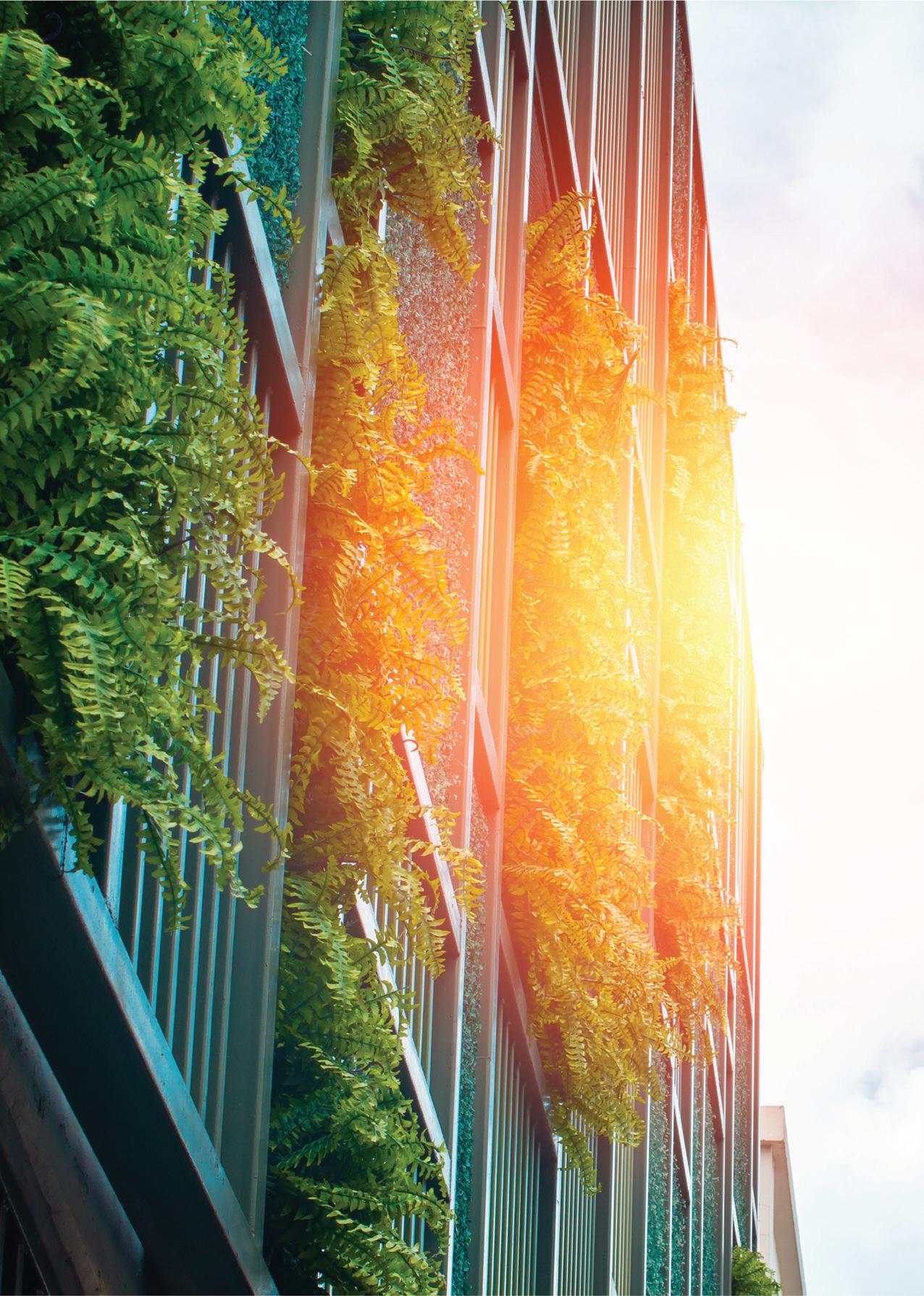
We connect communities to sustainable and equitable energy services, now and for the future.
By working with communities to make it easier for them to access and share the benefit of the latest innovations in sustainable technologies.
Solar PV Systems
EV Charging Stations
P: 1300 791 970 E: Enquiries@WINconnect.com.au www.WINconnect.com.au
Battery Storage
AUSTRALIA’S RENEWABLES JOURNEY: MOVING FROM FOSSIL FUELS TO CLEAN ENERGY POWERHOUSE
by Imogen Hartmann, Assistant Editor, Energy Magazine
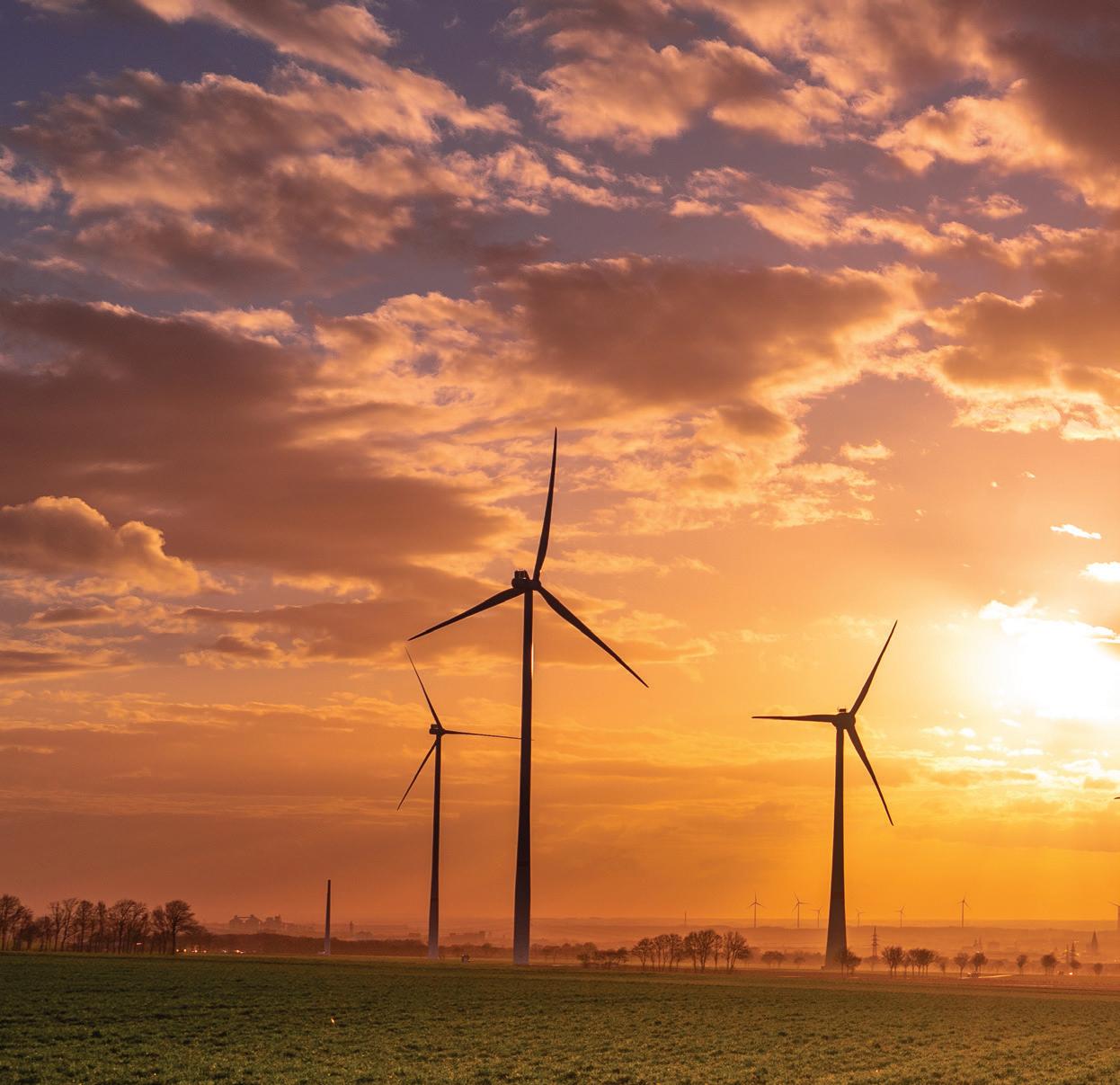
Renewables are a hot topic in the Australian energy industry as the sector evolves and transforms.
Australia’s abundant natural resources means a slew of potential for renewable energy, but moving from potential to delivery can be challenging. Here, we take a look back at Australia’s energy past, consider our potential, and look at some of the clean energy projects delivering big results around the country.
With Australia being a member of the 2016 Paris Agreement, energy makes up a big component of the federal interest in meeting carbon emissions commitments. However, renewable energy still only accounts for a small percentage of Australia’s total energy production and consumption.
In 2019, total electricity generation in Australia was estimated to be 265,117 gigawatt hours (GWh), and fossil fuel sources contributed 209,636 GWh (79 per cent) to this total. Coal accounted for the majority of electricity generation, at 56 per cent of total generation in 2019.
Renewable sources contributed 55,481 GWh (21 per cent) of total electricity generation in 2019, an increase of 12 per cent compared with 2018.
Historically, much of Australia’s energy needs have been met by fossil fuels because of the abundance of these low-cost coal resources, which have underpinned some of the cheapest electricity in the world. But times are changing. Recently, in a study providing estimates of the cost to generate electricity from new power plants, AEMO and the CSIRO concluded that wind and solar are clearly the cheapest new form of electricity generation.
These findings held true even while acknowledging the need to factor storage
22 November 2020 ISSUE 12 www.energymagazine.com.au RENEWABLES
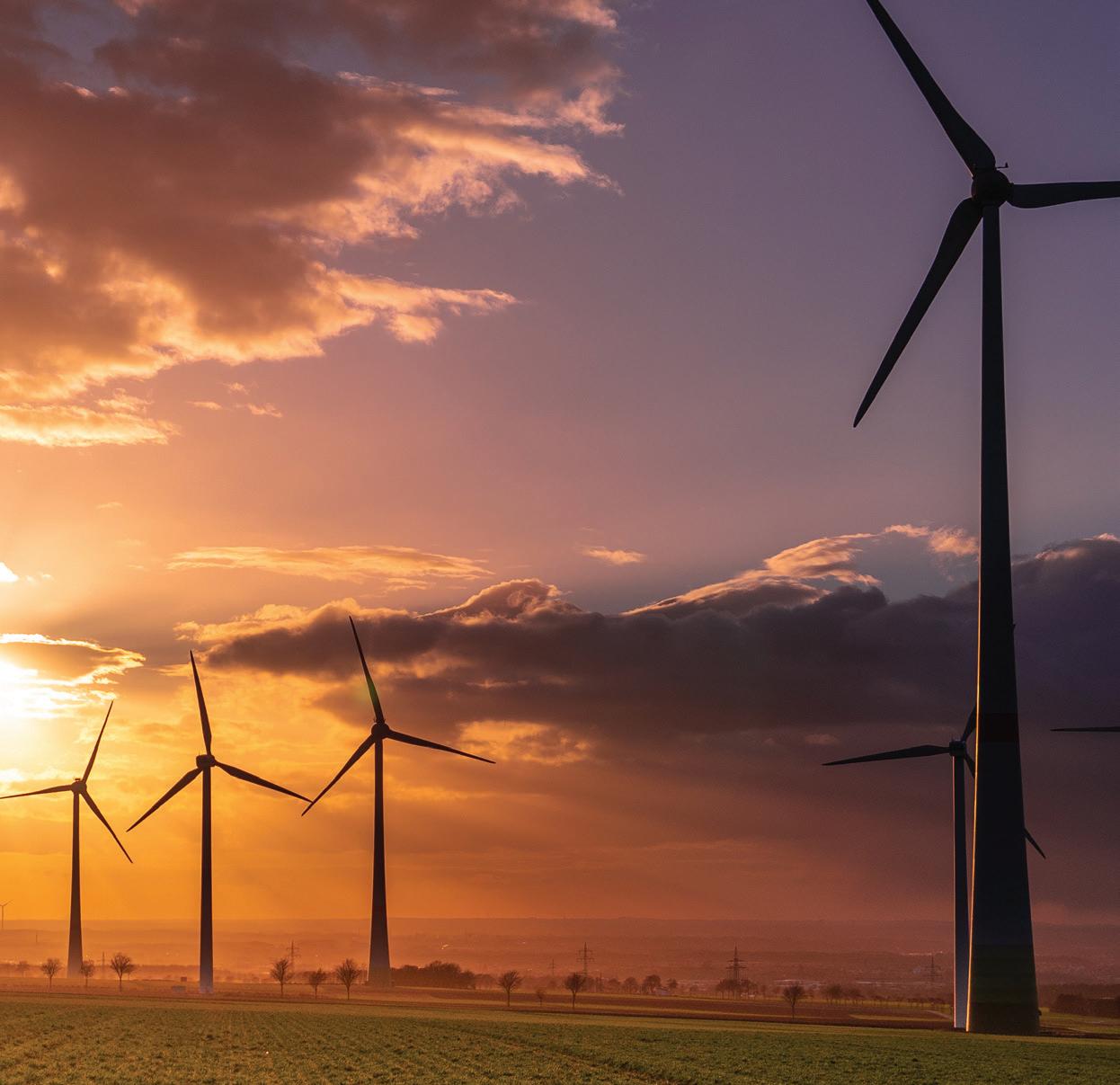
into new wind and solar projects. Even when variable renewables are backed up with two or six hours of battery or pumped hydro storage, the renewable generators were able to undercut their competitors.
Our fossil fuel history
Black and brown coal can be found throughout the country, with the most significant black coal resources located in the Bowen-Surat (Queensland) and Sydney (New South Wales) basins.
Australia’s annual thermal and metallurgical coal exports are worth more than $40 billion, mainly to Japan, India, European Union, Republic of Korea and Taiwan, making it one of Australia’s largest commodities.
The Gippsland Basin in Victoria holds most of Australia’s very large brown coal resources, where it is primarily used for electricity production. Current rates of production indicate that there are nearly 500 years of brown coal resources remaining.
Meanwhile, the Carnarvon, Browse and Bonaparte basins off the north-west coast house a significant amount of Australia’s large conventional gas resources. There are also smaller resources in the Gippsland Basin offshore Victoria and the onshore Cooper-Eromanga Basin in South Australia. EDR of conventional gas is adequate at current levels of production for around 60 years.
Coal seam gas (CSG) resources are growing due to increased exploration, with the Bowen, Surat and Sydney basins being identified for their significant economic demonstration of resources, in addition to the major coal basins of Eastern Australia.
Though small by world standards, Australia’s crude oil resources, found largely in the Carnarvon and Gippsland basins, are bolstered by significant condensate and LPG resources associated with the major largely undeveloped gas fields in the Carnarvon, Browse and Bonaparte basins off the north-west coast of Western Australia. There are still a number of sedimentary basins yet to be assessed.
23 www.energymagazine.com.au November 2020 ISSUE 12 RENEWABLES
The driving force of renewables
Currently, renewable energy sources make up small proportions of Australia’s electricity generation. Of the 21 per cent of Australia’s total electricity generation that comes from renewable energy sources, seven per cent comes from wind, seven per cent also comes from solar, and hydropower contributes five per cent.
The share of renewables in total electricity generation in 2019 was the highest since levels were first recorded in the early 1970s.
In addition to the major contributors, Australia is also home to a variety of other renewable energy sources including geothermal, bioenergy, ocean/wave power and hydrogen, which is expected to both play a major role in Australia’s future energy mix, as well as becoming a significant export for the country.
With wind, solar and hydropower being Australia’s most common forms of renewable energy, wind is the most widespread, solar is the most well-known, and hydropower is the oldest form of renewable generation.
Wind power
Wind power is electricity generated by wind turning the propeller-like blades of a turbine around a rotor, which spins a generator, which creates electricity.
Commonly, wind turbines are located on hilltops or near the ocean – with some wind turbines being built in the ocean, either floating on the surface or using large pylons extending to the seafloor.
The windmill shape is the most common, although this can vary and is often being tested and adjusted across the world.
Thanks to several new projects commissioned in 2019, wind energy overtook hydro power as the leading source of renewable energy for the first time ever. The cumulative installed capacity of wind energy in Australia has been steadily growing, and has more than tripled since 2010.
Wind is one of the lowest-cost sources of new electricity supply in Australia, and with the cost of utility-scale wind energy expected to continue to fall, new wind farms are expected to continuously deliver cheaper electricity.
Solar power
Solar energy is produced from the heat and light of the sun, which is then converted into electricity or used to heat air, water or other substances. Solar energy can also be used to create solar fuels such as hydrogen.
The process of harnessing solar power can be divided into two types: solar photovoltaic (PV) and solar thermal.
Solar PV uses a technology called a semiconductor cell or a solar PV cell to convert sunlight directly into electricity.
A common form of solar PV is solar panels, where the PV is typically encased in glass and an aluminium frame. One or more panels can be installed to power a single light, cover the roof of a house for residential use, or be assembled into a large-scale solar farm generating hundreds of megawatts of electricity.
Solar thermal energy is when sunlight is converted into heat (thermal energy), which can be used for a variety of purposes, including creating steam to drive an electricity generator. A refrigeration cycle can also be derived from heat energy to produce solar-based cooling.
The two main types of solar thermal technologies include:
1. Small-scale thermal technology used for space heating or to heat water (such as in a solar hot water system)
2. Large-scale power generation using a field of mirrors to reflect sunlight onto a receiver, which shifts the heat to a thermal energy storage system, where the energy can then be released from storage as required.
Hydropower
Moving water (usually from a dam or reservoir) being converted into energy is called hydropower.
The electricity is produced as the water is passed through an electricity generator known as a turbine, which drives the generator to convert the motion into electrical energy.
Hydropower is one of the oldest and most mature energy technologies, having been used in various forms for thousands of years, and provides some level of electricity generation in more than 160 countries.
Pumped hydro energy storage (PHES) is an emerging form of hydropower which differs in that it uses two dams, with one higher than the other. Water can then be pumped from the lower dam into the higher one when demand for energy is low, so that excess energy from the grid, or wind or solar farms, can be stored until the energy is required.
This process can be reversed by returning the water to the lower dam using a hydroelectric turbine, aided by gravity, releasing the stored energy. The generation of hydroelectricity in this manner is almost immediate, and is available to be fed into the grid quickly when demand for electricity spikes.
Renewables around the nation
Because of Australia’s diverse landscape and ecosystem, the spread of generation
from different renewable types differs from state-to-state, depending on what’s most available and accessible.
Western Australia
A recent 20-year forecast of Western Australia’s power system indicated a huge increase in renewable generation. The modelling anticipated there would be a strong uptake in wind power and that rooftop solar would continue to displace traditional forms of generation.
Current renewable projects and achievements include:
» The 132MW Merredin Solar Farm in the Wheatbelt region – the state’s largest operating PV project.
» The 180MW Warradarge Wind Farm, near Eneabba, with 51 turbines – among the largest in Western Australia with a tip height of 152m, sporting some of the longest blades onshore at 66.6m.
» The $39.87 million Perth Wave Energy Project – the world’s first commercialscale wave energy array that is connected to the grid and has the ability to produce desalinated water.
» The $495 million East Rockingham Waste-to-Energy project, recovering energy from 330,000 tonnes of residual waste per annum to produce 28.9MW of power.
» The Asian Renewable Energy Hub, a large-scale wind and solar hybrid renewable energy project near Port Hedland.
South Australia
South Australia leads the nation in terms of renewable energy commercialisation and potential. It is home to some of the windiest and sunniest places in Australia, and current Energy Minister Dan van Holst Pellekaan has set himself a goal of getting the state to its ambitious target of net 100 per cent renewable electricity before 2030.
Current renewable projects and achievements include:
» The Lincoln Gap Wind Farm, which will ultimately consist of 464MW of wind turbines.
» South Australia’s Virtual Power Plant (SA VPP) – the largest virtual power plant in the country.
» Hydrogen Park South Australia (HyP SA) – Australia’s largest renewable hydrogen project.
» A hybrid wind and solar plant on the cards at Port Augusta Renewable Energy Park.
» A record supply of 100 per cent of the state’s energy needs by solar power for one hour on 11 October 2020, using the state’s 288,000 PV rooftop systems to provide 992MW and largescale solar 313MW.
24 November 2020 ISSUE 12 www.energymagazine.com.au RENEWABLES
Tasmania
Tasmania has a plan to become a global renewable energy powerhouse with a renewable energy target which would see the state double its renewable energy generation by 2040.
Tasmania has also long been seen as the home of hydropower, with an extensive network of hydroelectric dams across the state.
Current renewable projects and achievements include:
» Project Marinus, a 1,500MW second undersea interconnector that would help deliver renewable energy from Tasmania to Victoria to help stabilise the national grid.
» Battery of the Nation, a nation-leading pumped hydro storage facility.
» The 5MW George Town Solar Farm, which will be Tasmania's first largescale solar farm.
» The 12.5MW Wesley Solar Farm, which will be Tasmania’s largest solar farm.
Northern Territory
With so many of the Northern Territory’s communities living remotely, reliable offgrid energy sources are critical for the state to bring power to the residents. This is why local and remote solar systems are one of the more commonly utilised renewable energy sources in the Territory.
Current renewable projects and achievements include:
» The $59 million NT Solar Energy Transformation Program (SETuP), which deployed medium and high penetration renewable energy systems to 26 remote communities.
» Northern Territory Government solar and battery stimulus packages for the purchase and installation of solar PV systems with batteries and for adding batteries to existing systems.
Victoria
The Victorian Government is focused on increasing the penetration of renewables in the state, and recently increased the Victorian Renewable Energy Target (VRET) to 50 per cent by 2030.
Current renewable projects and achievements include:
» In September, the Victorian Government announced the second round of the VRET Auction, testing the capacity of industry to deliver at least a further 600MW of renewable energy.
» The expansion of Victoria’s Solar Homes program, allowing eligible landlords to apply for an interest-free loan in addition to the existing rebate available.
» A $15.3 million package of renewable energy investments to help reduce the state’s emissions, including $10.3 million for energy efficiency and affordability improvements, including solar installations on public buildings on crown land; $4 million to fund energy efficiency upgrades for hot water systems and lighting in public housing high-rise properties across Victoria; and $1 million in grants to help regional communities deliver renewable energy projects.
New South Wales
NSW is a leader in the development of large-scale solar projects. These solar farms support jobs and investment in regional NSW, help to diversify the state’s energy mix and drive down costs for future large-scale solar developments.
There are already 16 major operating large-scale solar farms in NSW, and current renewable projects and achievements include:
» The development of three Renewable Energy Zones, including an 8,000MW zone in New England and a 3,000MW zone in Central-West Orana.
» A state-government set target of up to ten per cent hydrogen in gas networks by 2030.
Queensland
Home to abundant sunshine, it’s little wonder that Queensland has invested heavily in solar energy infrastructure for the state.
Current renewable projects and achievements include:
» The development of three Queensland Renewable Energy Zones located in southern, central and northern Queensland, for which the government has allocated $145 million.
» The Western Downs Green Power Hub near Chinchilla, 250km north-west of Brisbane. At a size of 460MW of installed solar panels once built, it will be Australia’s largest operating solar farm. The site also holds up to 150MW battery energy storage potential.
» The construction of a new wind farm in Warwick, the state’s first publiclyowned new renewable energy generation in 20 years.
Australian Capital Territory
With one of Australia’s most progressive governments, the ACT is making waves when it comes to the development of its renewables scene. Since January 2020, the territory has been powered by 100 per cent renewable energy, which is achieved through a combination of sourcing renewable energy from other states, as well as generating its own clean energy within the territory.
Current renewable projects and achievements include:
» Evoenergy’s Ginninderry Residential Battery Trial, which will provide subsidised residential batteries for up to 75 homes in Ginninderry in Stage 1A. The project has been designed to explore how small-scale solar and batteries interact with local electrical infrastructure in areas of 100 per cent solar uptake.

» The ACT Labor Government has committed to building a 250MW battery system if re-elected, which would be one of the biggest battery storage systems in Australia.
25 RENEWABLES
FEDERAL BUDGET MISSES A TRICK, BUT STATES PICK UP THE SLACK
by Kane Thornton, Chief Executive, Clean Energy Council

With the COVID-19 pandemic plunging Australia into its first recession in almost 30 years, the October Federal Budget was touted by the Federal Government as one of the most important since the Second World War. As such, it represented an enormous opportunity to modernise the energy system and create the building blocks for a renewable energy export industry, all while significantly reducing Australia’s emissions profile.
Unfortunately, the Budget failed to grasp this opportunity fully, all but ignoring the considerable potential of renewable energy to create jobs, drive investment and reduce emissions. However, the Budget did provide some positive signs – both from the government and the opposition – that the ideological heat may finally be coming out of the energy policy debate and that some degree of bipartisanship on energy could be possible.
Missed opportunity, but some progress made
In the leadup to the Budget, the Clean Energy Council outlined its vision for the economic recovery in A Clean Recovery, a comprehensive package of reforms to use renewable energy to inject more than $50 billion into the economy and create over 50,000 jobs in regional Australia while building the infrastructure necessary to develop a 21st-Century electricity system.
Despite receiving enormous support from right across the spectrum – including big business, community groups, energy experts and economists – the government ignored most of the measures outlined in A Clean Recovery, passing up the opportunity to create thousands of clean energy jobs and drive unparalleled investment in rural Australia.

26 November 2020 ISSUE 12 RENEWABLES
However, there were some positives for the industry, with the Budget locking in previous commitments to extend the Australian Renewable Energy Agency and support important transmission investments. Other new initiatives such as the instant asset write-off available for businesses will also likely boost the uptake of commercial-scale solar, while a range of programs to develop skills and workforce capability will likely help develop the clean energy workers of the future. There were also some encouraging signs for women wanting to work in the renewable energy industry, with the allocation towards women in science, technology, engineering and maths likely to result in a more inclusive and diverse workforce.
Hope for truce as Opposition replies
The Clean Energy Council also lodged a pre-Budget submission in the leadup to the Budget, which contained many of the measures outlined in A Clean Recovery. One of our major recommendations was for the establishment of a future transmission fund to help deliver the Australian Energy Market Operator’s 2020 Integrated System Plan (ISP). This would address one of the most significant challenges currently facing the renewable energy industry – underinvestment in the grid stifling new generation investment, constraining existing generation and resulting in increased energy security and reliability challenges and higher power prices.
It was, therefore, a significant boost to the industry to see the Federal Opposition give a prominent place to this recommendation in its Budget reply through the announcement of the Rewiring the Nation Corporation. According to the Labor party, the new body would take advantage of the Commonwealth’s ability to borrow at lower interest rates to fund projects needed to rebuild the electricity grid that has been identified in the ISP. With funding of $20 billion, the plan is an ambitious proposal to provide network businesses and private investors with the certainty they need to make the necessary financial investments in these long-lived assets promptly.
Putting aside the various announcements for a moment, one of the most notable things to come out of the Federal Budget was the lack of criticism from both sides of politics on the other’s energy policies. This may have been a result of energy taking a back seat to the debate on the COVID-19 recovery, but it could also be because the measures outlined were far more pragmatic and sensible than we’ve previously been used to in the energy policy space. While it would be a courageous person to predict that this signals the end of the energy policy wars that have plagued Australian politics for the past two decades, it does provide some hope that the debate has shifted enough to allow some progress to be made on federal energy policy finally.
State initiatives the gold standard for energy ambition
Regardless of whether this is a new era for federal energy policy in Australia or yet another false dawn, the clean energy transition continues to gain momentum due to the outstanding work of state and territory governments. Throughout this year, Queensland and New South Wales have committed to vast new renewable energy zones, Victoria has announced another reverse auction for 600MW of new renewable energy capacity and Western Australia has embraced clean energy in its 20-year energy plan. When added to the world-leading renewable energy penetration in South Australia and Tasmania’s ambition to achieve 200 per cent renewables, it is clear that the states and territories are doing the heavy lifting in the continued absence of federal leadership.
The Federal Government’s dithering and delaying on energy policy has finally caught up with it, as the states and territories have taken matters into their own hands. This has left Australia with an electricity system that is in urgent need of reform, and significant work will now be required to ensure that Australia’s electricity system delivers the price, reliability and environmental standards that Australians expect. While this year’s Federal Budget made some tentative steps in the right direction, much more will need to be done in the coming years to make up for the time wasted across two decades of energy policy inaction.
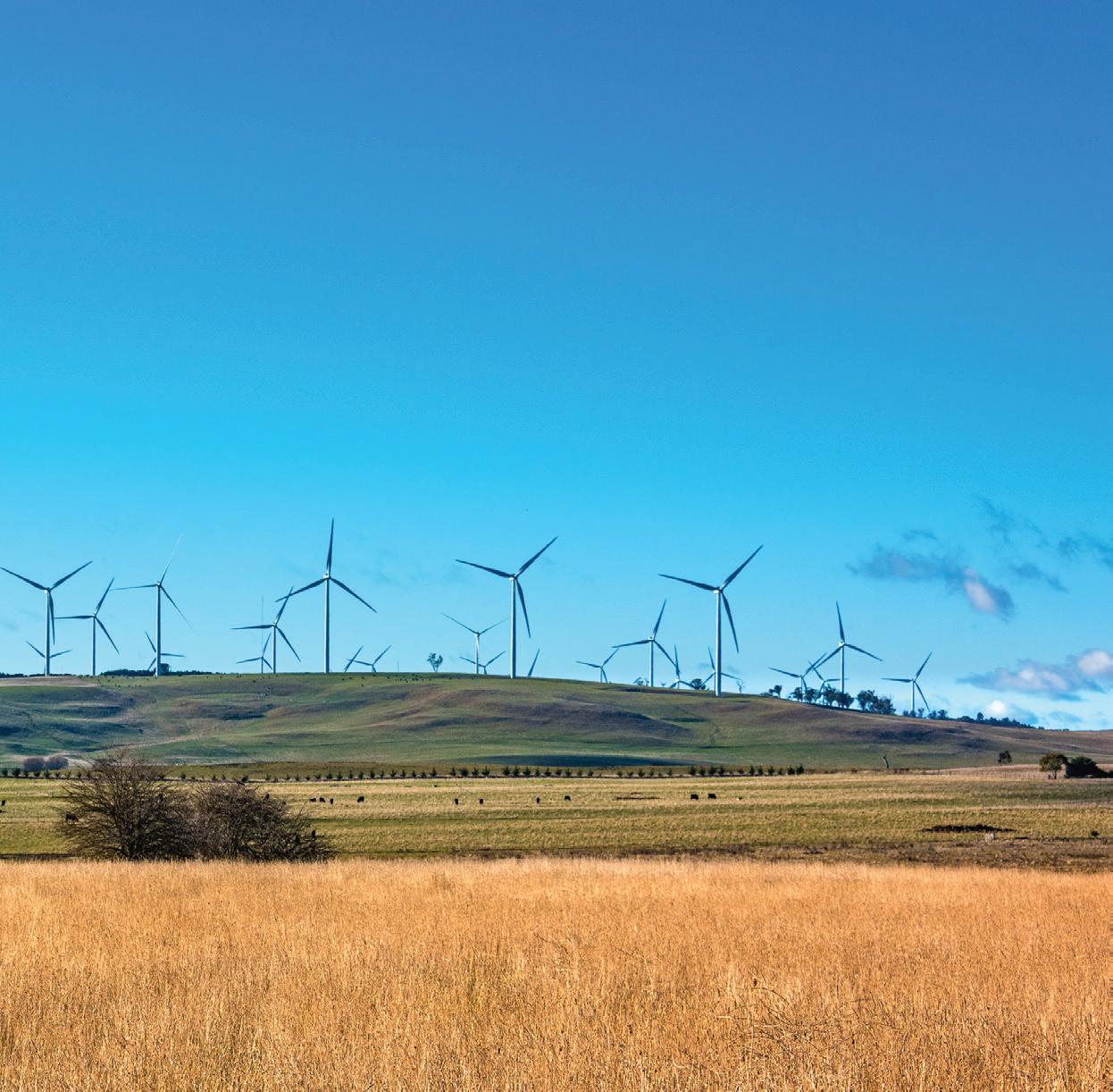
27 RENEWABLES
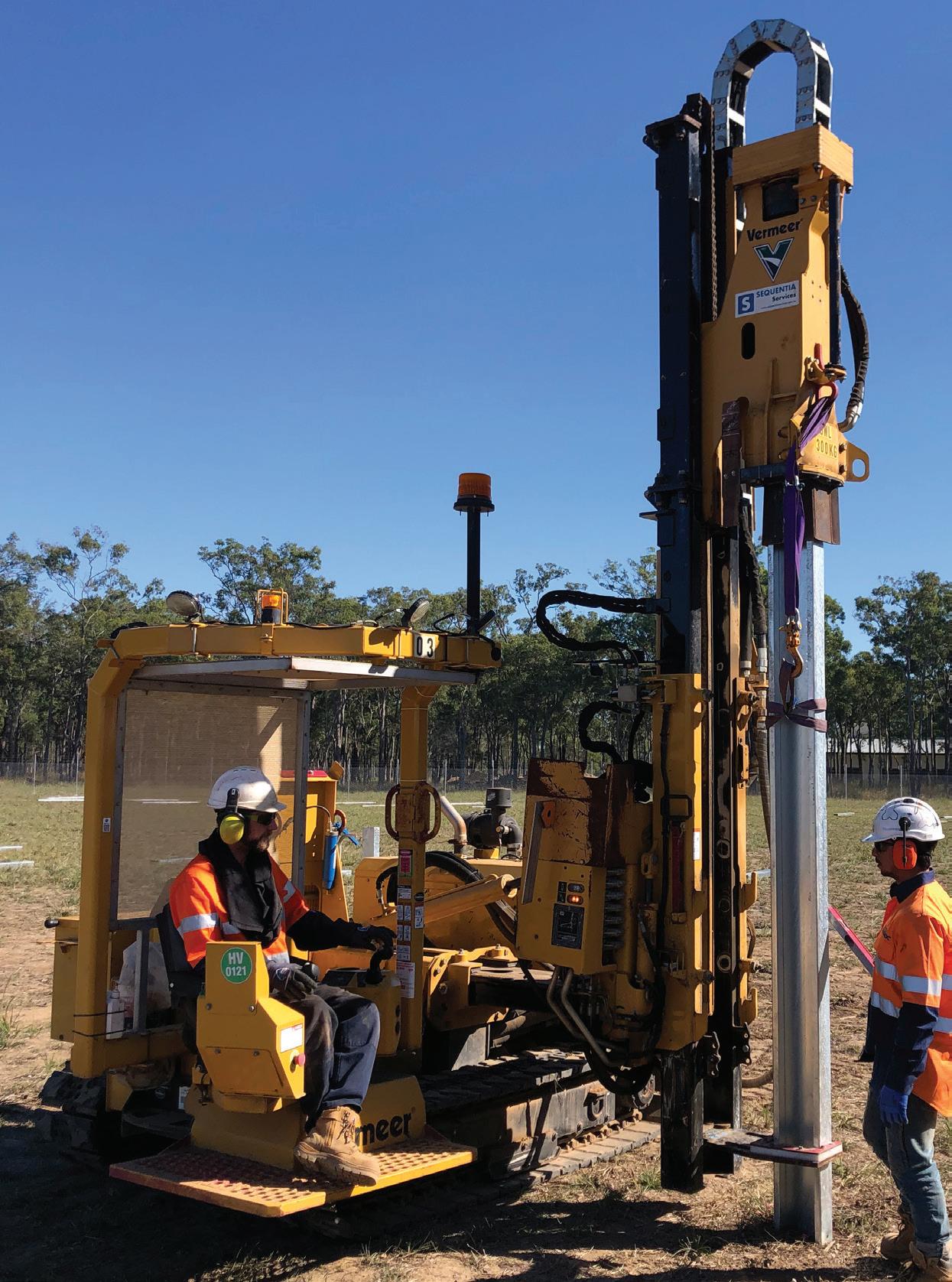
DEALER REACH MEANS LESS DOWNTIME FOR SEQUENTIA SERVICES
28 November 2020 ISSUE 12 www.energymagazine.com.au RENEWABLES ENERGY PARTNER CONTENT
Sequentia Services Vermeer PD10 Solar Pile Driver being put to work.

Renewable energy construction consultants Sequentia Services looked closely at three key things they needed from a machinery supply partner when they started business in 2016 – safety, support and performance, and Vermeer Australia ticked all the boxes. They’ve been working with them ever since.
Sequentia Services offers test piling, mechanical construction, trenching and balance of plant services to the solar sector.
Eamon Doyle, Managing Director of Sequentia Services, said they did some initial research, but all signs were pointing to Vermeer equipment.
“Over the last four years we’ve bought six Vermeer PD10 piling rigs, a VSK100DP-1600 vacuum excavator mounted on an Isuzu FYH truck, and two trailer mounted hydro vac trailer units. The fleet is out on the job all the time. We currently have four PD10s out helping install solar on Wellington Solar Farm, and the hydro vac units are constantly out on both wet and dry hire,” said Eamon.
“Safety of course is always our number one priority with machinery, and Vermeer has really thought through all aspects of operator safety. The PD10s have a seated position for the operator, where they have a clear view of everything, meaning the risk to the operator is significantly reduced with them sitting on the machine, rather than standing beside it.”
Eamon said that Vermeer Australia has always had a great branch network, but the recent consolidation of Vermeer Australia under the RDO Australia Group banner (with John Deere construction and forestry dealer RDO Equipment, and agricultural dealerships Vanderfield and Chesterfield
Australia), has meant they now have access to an even wider footprint of parts and service technicians and branches.
“Large-scale solar projects are not generally constructed in metro areas, so access to parts and service technicians are sometimes hard to come by. With the expanded branch network, we’re always in close proximity to a parts counter and a service technician when we need them. This means our machines can have less downtime and are getting jobs completed faster.
“Speed and accuracy are also really important when working on large-scale solar projects. The machines work in tough conditions, with millimetre accuracy tolerances, and we’ve found the PD10s can do just that,” Eamon said.
Eamon also said that it’s hard to fault the team he works with at Vermeer Australia, from the sales and after-sale support, they always offer first-class service.
“They always go the extra step to provide us with first-class support. We can make a phone call to Vermeer Australia and know action will be taken immediately.
“While there’s a fair amount of economic uncertainty at the moment, we continue to remain quite busy. We like to think this is due to the reputation we have created and the standard of work we carry out, and this is in no small part, thanks to the Vermeer equipment we use and the service they provide us.”

29 www.energymagazine.com.au November 2020 ISSUE 12 ENERGY PARTNER CONTENT RENEWABLES
Eamon Doyle, Managing Director of Sequentia Services, pictured with Vermeer Australia’s National Major Accounts and Projects Manager, Ken Smith.

STRUCTURED PLAN TO HELP FLATTEN AVIATION'S CO2 CURVE
30 November 2020 ISSUE 12 www.energymagazine.com.au RENEWABLES

As COVID-19-related border closures have curtailed commercial aviation activity globally, the sector continues to deal with another, longer-term challenge – the need to flatten its steep CO2-emissions trajectory in the face of stricter decarbonisation targets.
31 www.energymagazine.com.au November 2020 ISSUE 12 RENEWABLES
By 2050, demand for air travel is predicted to rise to over eight billion passengers per year (based on pre-COVID trends), meaning commercial aviation's carbon footprint could triple in size by mid-century.
Acknowledging the need for action, in 2009, the sector's peak body, the International Air Transport Association (IATA), set a target of reducing sector emissions to 50 per cent of 2005 levels by 2050 – equivalent to a 90 per cent reduction per passenger-mile.
The sector has responded by achieving fuel-efficiency improvements of around two per cent annually, but a deeper transformation will be needed to meet IATA's 2050 decarbonisation target and enable the sector to operate sustainably into the future.
A key to that transformation, according to a recent joint CSIRO/Boeing report, is clean hydrogen, generated from the electrolysis of water, via renewable energy sources like solar and wind.
Step-by-step transition
The CSIRO/Boeing report, Opportunities for hydrogen in commercial aviation, sets out a series of steps that the aviation sector can take over the next 30 years to shift its dependence from carbon-emitting fuels and power sources to low- or zeroemissions hydrogen.
The analysis covers airports and ancillary transport and services, as well as aircraft.
The steps are based on expected timeframes for development and take-up of the hydrogen technologies involved, ranging from the short-term (the next five
to ten years), to medium-term (to 2035), to long-term (2050 and beyond).
Lead author, Sam Bruce – Manager, Global, CSIRO Futures – said that by identifying energy-transition opportunities now, the report gives industry, research agencies and governments time to assess and prioritise investment opportunities, and put in place the right incentives, regulations, policies and standards.
The first step begins with progressively replacing diesel- and petrol-powered ground support vehicles and equipment (or GSE) that service airport operations with electric/fuel-cell equivalents.
The second step is based on the gradual substitution of kerosene-based aviation fuels – a high-use operating material in commercial aircraft – with a fuel-blend based on drop-in 'electrofuels' derived from clean hydrogen and waste CO2.
The third and final step of the plan –developing 100 per cent hydrogen-powered, long-distance jet aircraft – is still somewhat conceptual, according to Mr Bruce and his co-author, Dr Chris Munnings, a senior researcher with CSIRO Energy Technology. How that final phase plays out will depend on what happens with environmental regulations and hydrogen technology in the meantime.
Airports as clean energy hubs
The first stage of the plan – a shift from diesel/petrol GSE to hydrogen-fuel-cell powered GSE – could realistically start tomorrow, said Mr Bruce. Large airports could start retrofitting and replacing existing forklifts, buses, cars and back-up generators with off-the-shelf hydrogen-fuelcell equivalents.
“The GSE is the mature technology, the low hanging fruit,” said Mr Bruce. “This first stage is more about economics and providing the right incentives for airports to change over their GSE fleets and overcome that initial capital cost barrier to hydrogen technology – even though long term we expect hydrogen and fuel-cell solutions to become more economical.”
At the same time, investment incentives could propel the continued development of fuel-cell versions of special-purpose GSE, such as baggage loaders and pushback tugs, which will become more affordable as demand increases.

“That first stage is about taking mature technology from the automotive sector, and using it or in some cases modifying it, to get that foot in the door for hydrogen into the airport,” said Dr Munnings.
“When the drive trains of GSE vehicles go from diesel engines to fuel cells, it will improve their efficiency. Even though hydrogen fuel is slightly more expensive, in many cases the cost of running fuel-cell vehicles will go down, because they’re a lot more efficient.
“So that starts to build scale in the hydrogen supply chain. It also starts to get all of the standards and regulations around getting hydrogen onto an airport resolved – the legislative challenges, the safety challenges – they’re all worked out when you start switching the bus that takes passengers to the aircraft to fuel-cell.”
The report also highlights the opportunity for airports to become clean hydrogen transport hubs, with on-site electrolysers – powered by solar or wind – generating hydrogen from water to supply public refuelling stations.
32 RENEWABLES
These on- or near-airport refuelling stations could service buses, fleet vehicles and – down the track – trains, increasing the demand for on-site hydrogen production at airports. Airports in several countries – including Japan, the US, the UK, Norway, Korea and Germany – have already introduced or are introducing public refuelling stations.
Longer term – the electrofuels era
As airport and logistics operators deploy more fuel-cell equipment and develop on-site electrolyser facilities on the ground, airlines can begin a transition to more sustainable aviation fuels (SAFs) for long-haul aircraft.
To date, commercial aviation's take-up of the most well-known SAF, biofuel, has been slow. Other electrofuels, however, have the potential to be a game-changer, according to the report.
Electrofuels are made by reacting clean hydrogen with waste CO2 captured from biogas or wastewater treatment. CO2 from fossil fuel combustion, however, brings its own carbon footprint. An emerging technology that has triggered strong interest globally is direct air capture of CO2 via large fans and special filters – a technology that could dramatically boost the prospect of cheaper electrofuels production.
The resulting synthetic fuel can be blended with conventional fuel and simply 'dropped in' to existing aircraft, with no need for modifications.
Mr Bruce notes that while the cost of the electrofuels is high at the moment, the production processes are underpinned by a strong technological and regulatory base that can be used to ramp up future production and use.
"The electrofuels value chain and processes are all underpinned by mature technology," he said. "The three components – hydrogen production, CO2 capture and fuel synthesis – have already been de-risked.
"However, to date, there's been no large-scale, end-to-end commercial demonstration – from hydrogen production and CO2 capture, through to electrofuels."
Fuel-blending quotas
The report suggests that the most efficient way to introduce electrofuels to the aviation sector is to introduce blending quotas that increase over time – from a mix of 50 per cent electrofuels and conventional fuel, to 75 per cent electrofuels, to 100 per cent.
Over time, the bigger production plant capacity established to meet the demand generated by higher blending quotas will help reduce the cost of electrofuels.
"By 2040, with the investment priorities set out in the report, electrofuels might be only 1.5 to 2.5 times the cost of conventional jet fuel," said Mr Bruce.
"Because there's such a significant lead time, industry and government will likely need to find ways to limit the cost pass through, because jet fuel is such a material operating cost."
Mr Bruce said Australia, with its renewable energy resources and proven technical expertise, is well-positioned to become a key exporter of hydrogen and electrofuels, shipping to countries like Japan, Korea and Germany, which are all turning to clean hydrogen to reduce their CO2 emissions.
"So Australia would want to be producing electrofuels as well as clean hydrogen, because hydrogen on its own has a low volumetric density and it's much easier to transport in the form of a synthetic fuel.
“At the moment, Germany has the key technical expertise, and is leading the way in developing larger electrolysers and in producing electrofuels.
“Australia has abundant and cheap renewable resources and technical expertise as well. In fact, the key focus of the recent agreement between Australia and Germany is building global supply chains for hydrogen.”

Whole-of-sector approach
Mr Bruce is cautiously confident that the gradual phase-in of electrofuels, as set out in the report, will help commercial aviation meet IATA's 2050 emissions reduction target.
But such a transition would also require all players involved with the sector to commit to such a plan.
"This report shows a way for the aviation sector to decarbonise. It shows that we can start today, the technologies are here, and here are the steps you need to take.
"Even though there's a strong technical and regulatory base to build upon, the shift to hydrogen is going to require a significant, global, cross-sector effort, in terms of going from commercial demonstrations to producing the significant volumes you need to build an electrofuels industry.
“It is scale that’s needed to decrease the cost of clean hydrogen. There’s still significant R&D required as well to improve costs, but the volumes are significant.”
33 RENEWABLES
BATTERIES IN THE BURBS:
E XPLORING THE POTENTIAL
by Lachlan Blackhall, Head, Battery Storage & Grid Integration Program, ANU

A team at the Australian National University has undertaken a significant project to explore the potential benefits of community batteries, as well as the attitudes of residents towards them. Here, they share some of their findings and explore the next steps for the energy industry.
34 November 2020 ISSUE 12 www.energymagazine.com.au DISRUPTION

35 www.energymagazine.com.au November 2020 ISSUE 12 DISRUPTION

Australia is a global leader in the uptake of renewable generation including wind and solar PV. Renewable wind and solar generation is already the cheapest form of new build generation, and as prices continue to decline over the coming decades, the rapid uptake of renewable generation is set to continue. To support this massive uptake of renewable generation we are going to need a significant amount of energy storage. This energy storage is needed to fill in the gaps of renewable generation and ensure that we continue to have a reliable, secure and efficient electricity system.
In large part, this energy storage is going to come in the form of battery storage including both lithium and flow battery chemistries. Since 2015, we have seen an increasing uptake of battery storage in Australia, initially in the form of residential batteries. The uptake of residential battery storage has largely been driven by customers who already have solar PV on their roof and who are keen to capture the energy generated during the day and use it at night when the cost of electricity is often higher.
In 2017, residential battery storage began to be complemented by the installation of large utility-scale battery storage. The first notable utility-scale battery was the Hornsdale Power Reserve (HPR), better known as the Tesla Big Battery. Since that initial installation, we have seen a number of other utility-scale batteries being installed all over the country. These batteries are largely transmission connected and often co-located with utility-scale wind and solar farms.
As we start a new decade, we have big utility batteries at the centre of the grid and little residential batteries at the edge of the grid, but what about medium batteries in the middle of the grid? It is these medium-sized batteries, something we refer to as community or suburb-scale batteries, that are of interest to us at the Battery Storage & Grid Integration Program at ANU.
For the last 18 months, we have been undertaking an ARENAfunded project titled Community Models for Deploying and
Operating DER. Through this project, we have been investigating the social, technical and economic considerations for how to deploy and operate community and suburb-scale battery storage. We have been working on this project with a collection of partners including several distribution network service providers (DNSPs) and multiple community energy groups, retailers and consumer representatives. Now that we have concluded this project, we are excited to share the results.
So, first things first, what is a community or suburb-scale battery? These are batteries that are installed in your street or in your suburb, connected to the distribution network and have power capacities of up to 5MW. By being situated close to customers, they are uniquely suited to providing social, economic and technical benefits for customers, distribution networks and to the broader system.
To highlight how a community or suburb-scale battery might work, consider the following example. Instead of everyone in a suburb installing their own behind-the-meter battery in their house, local customers could instead access a virtual slice of the community battery. In this way, customers could export their solar generation during the day into the community battery, and then use the energy stored in the community battery during the evening when electricity prices are higher. In addition to storing excess local solar generation, the community battery could provide services to the local network, as well as participate in markets for energy and ancillary services. The ability to provide benefits to many stakeholders is one of the key reasons why we felt it was important to comprehensively investigate the opportunities for community batteries through this project.
For this project, we first identified the four key elements that describe a range of possible community-scale battery models. These elements include:
» Battery ownership – who will own the battery, and what regulatory considerations might arise due to ownership?
Crucially, how might battery ownership influence the prioritisation of benefits to different stakeholders?
36 November 2020 ISSUE 12 www.energymagazine.com.au DISRUPTION
Community batteries have the potential to allow residential solar users to get more out of their investment.

» Stakeholder participation – who is a stakeholder in the battery’s operation, and what is their legal and operational relationship with the battery? How do stakeholders benefit from their participation, and what technology is necessary to enable the battery operation?
» Network tariffs – what network tariffs are applied to energy flows into and out of the community battery, and how do network tariffs unlock or impact the benefits that can be delivered to stakeholders?
» Services delivered – what market services, such as energy arbitrage and frequency support, can community-scale batteries deliver? What non-market services, such as network support (demand response, voltage regulation), do community-scale batteries deliver? How can services be value stacked to maximise the battery’s utilisation and cost-effectiveness?
By undertaking a socio-techno-economic analysis of various permutations of these four key considerations, we were able to assess how different community energy models created value for energy users, distribution networks, electricity retailers and the broader electricity system.
Ultimately, we discovered that community batteries can deliver five essential benefits. They can:
1. Improve the fairness of the energy system
2. Build trust in the energy system by sharing value transparently
3. Increase the hosting capacity of the network
4. Bolster local resilience, including socially, economically, and electrically
5. Be cost effective by delivering services to many stakeholders
Unlike residential batteries, community batteries also potentially unlock the value of battery storage to all energy users, including customers who rent and do not own their own home. The potential for novel subscription services that we identified through this project also means that customers who couldn’t

afford a battery in their house would still be able to access the benefits of a community battery.
As part of our project, we conducted interviews and forums with industry stakeholders and members of the public. These revealed a set of themes that are central to people’s attitudes towards community batteries. Many energy sector participants saw significant potential benefits of community-scale batteries, including over behind-the-meter residential storage.
Through our work with customers, we identified that their interests are complex and nuanced, and they are interested in far more than just affordability – for example, there was strong concern over questions such as battery life-cycle, promoting local energy use, reducing carbon emissions, questions of fairness and how this technology would support the broader energy transition to renewables. We also discovered that customers were optimistic about the opportunity to rebuild trust and engagement with the energy sector, so long as trusted organisations were heavily involved in the operation of community batteries.
While we identified that there are no immediate barriers to deploying community batteries, we did identify that there are still some challenges that need to be resolved before the at-scale adoption of community batteries can become a reality. Perhaps key amongst these is to implement new tariff structures that do not penalise community batteries. Consequently, one of the key outcomes of the project was that we identified the need for more comprehensive trials and demonstrations to allow all stakeholders to better understand the implementation and operational complexity of using community batteries.
Notwithstanding the fact that there is still work to be done, it is exciting to understand the many benefits that could emerge from the at-scale adoption of community-scale batteries. We are confident that there is now a path for community and suburb-scale battery storage to complement residential and utility-scale battery storage to power our electricity grid into the 21st century.
37 www.energymagazine.com.au November 2020 ISSUE 12 DISRUPTION
Lachlan Blackhall.
SAFELY GROUNDED: TIMING MEASUREMENTS ON GAS-INSULATED SWITCHGEAR
by Andreas Nenning, OMICRON Austria
Circuit breaker testing in gas-insulated switchgear
The operating times during C, O, CO, etc., are measured and compared with the manufacturer's reference values for circuit breakers in gas-insulated switchgear (GIS). This allows the condition of the interrupter unit and the operating system to be assessed.
Test sets and the circuit breaker are usually connected by tapping the grounding switches on the switchbay. Due to the low-ohm ground connection resulting from the metallic GIS enclosure that runs parallel to the circuit breaker where both sides are grounded, there is no significant increase in the measured voltage or the resulting resistance at the time of the contact separation. Measuring the operating times is rendered impossible as a suitable resistance threshold value cannot be chosen. Therefore, testing methods such as the dynamic resistance measurement (DRM) cannot be used for measuring the operating times of GIS.
For this reason, timing measurements are often conducted with insulated grounding, or with grounding that is only on one side. Yet this carries the risk of capacitive coupling from adjacent components or switchbay sections on the non-grounded conductor. On-site testing using these methods is often impossible or prohibited in many cases.
Which alternative test methods have been used to date
Test sets that are based on measuring the dynamic circuit breaker capacity (DCM) provide an alternative to tests that are frequently prohibited when grounding is insulated or only done on one side. As a result of installing additional ferrite cores on the grounding switch, the parallel ground impedance can be increased when using the DCM test procedure. However, the assembly and setup is time-consuming. The feasibility of this process is also more restrictive and a variety of ferrite core types are needed, which increases the cost.
Current sensor measurement
CIBANO 500 offers a new, alternative method for measuring operating times in GIS – called the current sensor measurement (CSM) method. The operating time is measured via an inductive current change measurement using the parallel ground connection or the circuit breaker, while the GIS remains grounded on both sides (see Figure 1).

In order to do this, the circuit breaker is connected to CIBANO 500 via the circuit breaker MC2 accessory (see Figure 2).

The circuit breaker MC2 has a constant current source (e.g. IDC = 200A) and a measurement channel for the current sensor. The sensor is laid around the ground connection of the grounding switch (see Figure 3). The current change that is measured through the ground connection or the circuit breaker is then used to determine the switch response times. The circuit breaker remains grounded on both sides throughout the entire measurement.

Advantages of the CSM method
When using this new CSM method, the ground connections on the grounding switch don’t need to be removed and additional components don’t need to be installed. A current sensor just needs to be connected to the switchbay grounding switch. Since these sensors have a flexible design and can easily be installed on a multitude of different grounding switches, they are ideal for on-site applications in GIS installations. Therefore the CSM method is a faster and simpler alternative method for precisely measuring the operating times of a GIS that is grounded on both sides.
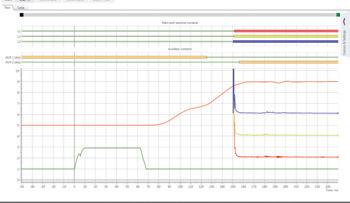
Did you know?
After timing measurements or high residual currents with transient DC components, there may be some residual magnetism left over in the GIS’s current transformer. CIBANO 500 also features the CT Demagnetization function, which quickly and easily demagnetizes the current transformer after timing measurements.
OMICRON is an international company serving the electrical power industry with innovative testing and diagnostic solutions. OMICRON products allow users to assess the condition of the primary and secondary equipment on their systems with complete confidence. Services offered in the area of consulting, commissioning, testing, diagnosis and training make the product range complete. Customers in more than 150 countries rely on the company’s ability to supply leading-edge technology of excellent quality. Service centres on all continents provide a broad base of knowledge and extraordinary customer support. All of this together with our strong network of sales partners is what has made our company a market leader in the electrical power industry. www.omicronenergy.com
November 2020 ISSUE 12 www.energymagazine.com.au 38 SWITCHGEAR ENERGY PARTNER CONTENT
Figure 1. Inductive measurement of the current change with the CSM method.
Figure 3. The current sensor is laid around the ground connection of the grounding switch and connected to circuit breaker MC2.
Figure 4. The Primary Test Manager™ software shows the results of the timing measurement using CIBANO 500 and the CSM method.
Figure 2. Measuring setup of the CSM method.


Safe testing of GIS circuit breakers
I often heard test engineers complain about timing tests on GIS circuit breakers - that they were hard to perform and generally unsafe. Our experts worked hard in order to overcome these challenges. Now I’m happy to share that we have successfully developed and demonstrated our new, improved solution, which is both safe and easy to use. With its flexible design, timing tests can be easily performed on almost any kind of GIS circuit breaker. The test engineer stays safe due to grounding on both sides.
www.omicronenergy.com/GIS-breaker info.australia@omicronenergy.com
General: 03 9473 8400 | Toll Free: 1800 223 177
CommunicationDigital
THE PRODUCTS AT THE HEART OF CRITICAL INFRASTRUCTURE
For products and services for the energy
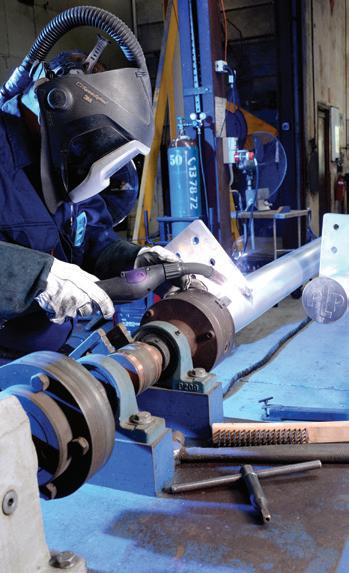
Preformed Line Products (PLP) is an Australian manufacturing company that has been supplying products to the electricity, telecommunications, cable television and data network industries, as well as specialised niche markets in Australia for 60 years. PLP’s extensive product range, innovative technologies and expert services help build, protect and maintain critical infrastructure.
PLP supplies high quality cable anchoring and control hardware systems for supporting, protecting, terminating and splicing transmission and distribution lines.
PLP Australia stocks over 20,000 parts at any one time, the foundation of rapid delivery and responsive service.
PLP’s advanced Australian manufacturing facility, located in Glendenning NSW, comprises forging, sheet metal work, a modern tool room with the latest CNC vertical machining centres and turret
punches, and a dedicated assembly line building product ready for delivery and installation.
PLP Australia has an on-site NATA accredited testing laboratory and quality assurance professionals to ensure all products meet the highest standards.
Experienced engineers provide technical support, installation, and inspection services using unmanned aerial vehicles accompanied by in-depth data analysis.
Skilled sales professionals and a dedicated team of onsite customer support staff are available to provide end-to-end assistance, from initial project costing to on-time delivery.
PLP Australia is part of the PLP Group of global companies that work in unison to provide outstanding market coverage in more than 140 countries around the world.
PLP’s commitment to innovation, along with outstanding product performance and exceptional customer service, are the hallmarks of its world-wide operations.

CTA Next Day Delivery
Preformed Line Products (PLP) provides a rapid turnaround service for a range of Compression Terminating Aluminium (CTA) palms used in substation terminations.
The range is compatible with AAC and ACSR conductors in sizes from 21.8mm to 33.8mm diameter, using standard AS palm sizes, and bend angles from 0° to 90° in 15° increments.
Three simple steps for CTA next day delivery
1 Call our customer service team on 1300 550 322 with the following information: conductor diameter, palm bend angle and palm configuration required
2 We will advise on the available configurations
3 Email your order to sales@preformed.com
www.preformed.com.au


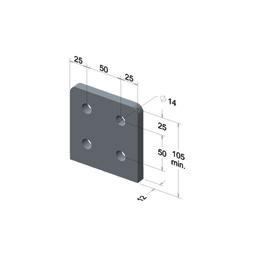




40 November 2020 ISSUE 12 www.energymagazine.com.au EQUIPMENT ENERGY PARTNER CONTENT
look
further than Preformed
sector,
no
Line Products.
AS1 AS10 AS2 AS5 AS8 AS11 AS1 AS4 AS10 AS2 AS5 AS11 AS1 AS4 AS10 AS2 AS5 AS8 AS11 AS1 AS4 AS7 AS10 AS13 AS2 AS5 AS8 AS11 AS14
Standard CTA palm configurations available for next day delivery include:
for 60 years
Preformed Line Products – Manufacturing in Australia
Looking for a complete solution for online events?

Combining our experience in publishing, live events, digital marketing and video production, Monkey Media has the capability to deliver a range of online events for your organisation.



Specialising in the energy, infrastructure and utility sectors, we combine our expert knowledge in these fields with our behind-the-scenes knowhow to help you deliver your events in a range of online formats.
We work closely with our partners to understand why and how you want to connect with your audience online, and can recommend the right solution to help you cut through and achieve the high levels of audience engagement and participation you’re looking for.
Some of the online events we can help you deliver include:
Webinars
Virtual conferences
Awards nights
Round tables
Online learning for a complete online event solution
9988 4950
03
www.monkeymedia.com.au/services/custom-virtual-events/
QUEENSLAND'S ELECTRIC SUPER HIGHWAY TAKES
Electric vehicles offer a range of benefits to consumers, and yet the uptake of these vehicles in Australia remains stubbornly low. In recognition of this, the Queensland Government implemented Queensland's Electric Vehicle Strategy to help encourage the uptake of EVs across the state. A key element of this strategy is the creation of Queensland’s Electric Super Highway, the world's longest electric super highway in a single state.

November 2020 ISSUE 12 www.energymagazine.com.au 42 ELECTRIC VEHICLES
The QESH fast-charging sites at Carmila, Queensland.
TAKES SHAPE
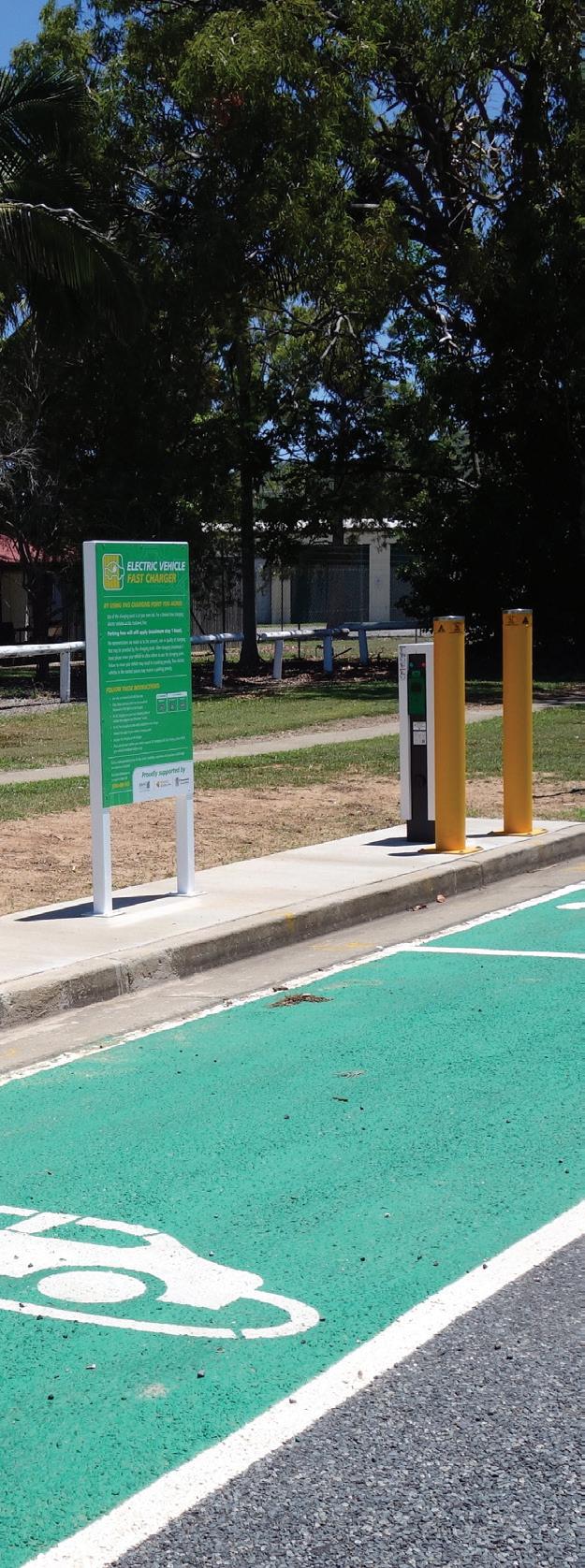
The Queensland Electric Super Highway (QESH) will feature 31 fast-charging sites, allowing Queenslanders and tourists to travel from Coolangatta to Cairns, and from Brisbane to Toowoomba in a low or zero emissions vehicle.
The fast chargers are installed in convenient, safe locations close to major highways where there are existing amenities, such as cafes, restaurants and shops. The sites were identified to allow motorists to easily charge their electric vehicle (EV) and enjoy a short break during their journey, allowing them to prepare for a safe onwards journey.
Phase 2 of the Queensland Electric Super Highway added 13 more fast-charging sites, and it is due for completion before the end of 2020. The new fast-charging site locations are at Ayr, Cardwell, Forest Glen, Gin Gin, Gunalda (Curra), Gympie, Innisfail, Ipswich, Mt Larcom, North Lakes, Port Douglas, Proserpine and Springwood.
These new sites continue to provide further reassurance for EV drivers that there is appropriate charging infrastructure in place and provide an incentive for future EV users.
Queensland Transport and Main Roads Minister Mark Bailey said “Since we were elected in 2015, the Palaszczuk Government has been committed to supporting more Queenslanders to use electric vehicles.
“Queensland was the first state in Australia to release an electric vehicle strategy.
“A key action from that strategy was building the QESH, which began operating in early 2018 and eventually included 18 charging sites.
“We made those charging stations free to use for the first 12 months to encourage people to try electric vehicles, and since that time we’ve also seen more affordable EV models come into the market.
“The QESH is still more affordable per charge than any other network in the country too.
“Queensland has the largest state-controlled road network in Australia, and the journey between Brisbane and Cairns is almost 1,700km.
“Motorists who may be thinking about making the switch to an EV need to have confidence that the charging infrastructure they need are easily found in regional areas, not just busy urban centres.
“The rollout of these new sites, which will be sponsored by RACQ under a new partnership with the State Government, means EV drivers are good to go and explore Queensland this summer.”
Mr Bailey said the $2.5 million investment in 13 more charging stations was well advanced, with civil works completed at most sites.
RACQ Head of Public Policy Rebecca Michael said the Club was proud to support ultra-low emission technology and vehicles.
“We’ve seen EV sales in Australia grow by 200 per cent in the past year and EV technology is only going to continue to rise in popularity, which is why we’re so keen to support this initiative and provide Queensland drivers with more options for travel,” Dr Michael said.
“We know ‘range anxiety’ can be a real concern for drivers afraid they can’t get from their desired location on one charge. Having a comprehensive and connected charging network across our state will give motorists confidence to switch to low emission vehicles.”
The QESH charging stations use green energy either through direct green energy credits or offsets, making them a carbonneutral and pollutant-free transport option.
More renewables (such as solar and wind) are being added to Queensland's energy generation mix, which means the energy used to charge EVs will become more green and sustainable.
An EV fully recharged by solar can save 2.7 to 3.8 tonnes of greenhouse gas emissions annually when compared to a fossil fuel vehicle (driving 15,000km per year).
www.energymagazine.com.au November 2020 ISSUE 12 ELECTRIC VEHICLES 43
ELECTRIC VEHICLES
The QESH has been built to help increase the number of public fast-charging stations available for electric vehicles. In the past, there was a lack of public charging infrastructure which may have discouraged consumers from buying an EV, and contributed to perceived range anxiety – a common misconception that EVs are impractical due to range constraints.
The actual reality is that most people charge their EVs at home, and we know from overseas markets that most users do not use a whole charge in a typical day. This means the widespread adoption of EVs will cause a cultural shift in the way we think about our own mobility needs – a shift from visiting the petrol station regularly to charging overnight or when the vehicle is not in use.
Queensland’s EV strategy
The QESH is part of the Queensland Government’s broader EV strategy, The Future is Electric: Queensland's Electric Vehicle Strategy, which outlines the state’s roadmap to a more sustainable, lower fossil fuel future for its roads.
The strategy outlines 16 cost-effective initiatives that the Queensland Government will implement to encourage consumers and support the uptake of these vehicles.
The initiatives will help empower the community, facilitate the transition to EV through charging infrastructure, support costeffective programs to promote the uptake of EVs, and prepare for further future actions that may be required.
The 16 initiatives have been classified into four groups: empowering consumers, enabling charging infrastructure, exploring cost-effective programs to support the uptake of EVs, and envisaging what future government action may be required to ensure Queenslanders benefit from this transition.
Under the empower banner, to provide Queenslanders with opportunities to investigate and experience EV technology and other related innovations, the Queensland Government will:
» Facilitate knowledge sharing and community engagement through the establishment of the Queensland Electric Vehicle Council
» Bridge the information gap by providing Queenslanders with information that supports informed technology choices and provide opportunities for the community to experience this innovative technology
» Empower local EV technology innovations
Through the enable initiative, to assist in overcoming the barrier of limited EV charging infrastructure, and prepare Queensland for the upcoming transition towards EVs, the Queensland Government will initiate:
» The Queensland Electric Super Highway network
» Regional EV infrastructure
» Workplace EV charging trial
» A national discussion on EVs
Under the explore theme, the Queensland Government has developed six programs to investigate and explore further ways in which it can support a transition to EVs, including:
» Transitioning government vehicle fleets
» Drive Electric Queensland
» Integrating EVs with public transport hubs
» Improving Queensland climate resilience using EVs
» Electrical infrastructure analysis of government buildings
» Feasibility of electric heavy vehicles
And under the envisage platform, the Queensland Government has developed three exploratory projects to envisage what future government actions may be required to ensure Queenslanders gain the maximum benefit from EVs. These are:
» Reuse and recycling of EV batteries
» Future mobility trends – shared/autonomous vehicles
» Electric public transport vehicles
What next?
The Queensland Government developed the QESH and its EV strategy in order to kick-start a conversation with Queenslanders about how to successfully navigate the transition to EVs to reap the benefits of this innovative technology.
The Queensland Electric Vehicle Council has been involved with the implementation of many of these programs, and will be consulting with industry partners and local communities to ensure Queensland keeps pace with global developments in the EV market.
The Queensland Government will continue work with the Queensland Electric Vehicle Council to explore other initiatives to support a transition towards EVs.

November 2020 ISSUE 12 www.energymagazine.com.au 44
For more information go to: www.qld.gov.au/electricvehicles
EV charging infrastructure at Cairns.
WHY AREN’T MORE AUSTRALIANS DRIVING EVS?
International interest in electric vehicles (EVs) is constantly increasing, with over three million EVs on the roads internationally and uptake expected to increase year upon year. However, with EVs making up only 0.2 per cent of Australian vehicles, there are clearly some roadblocks that are holding back the growth of EVs Down Under.

www.energymagazine.com.au November 2020 ISSUE 12 ELECTRIC VEHICLES 45
Of the 36 countries that make up the Organisation for Economic Cooperation and Development (OECD), 32 countries have higher EV sales than Australia, with the countries that have lower sales all classified as having emerging economies.
As a country of car lovers, and with steady access to the solar energy that generally fuels these vehicles, it’s surprising to many that EV ownership hasn’t risen more quickly in Australia.
While our country’s vast size certainly plays a part in range anxiety and poses challenges for the rollout of charging infrastructure, Australian consumer interest is also being influenced by upfront and ongoing EV costs, Australia’s network capacity, access to charging infrastructure, and barriers to purchase at the point of sale.
The perception of price
Perhaps the single biggest roadblock to EV uptake in Australia remains around price.
A total of 1,062,867 new vehicles were purchased in Australia in 2019, while an estimated three million used vehicles are purchased each year – suggesting that upfront vehicle cost is an important consideration for Australians.
With only 30,641 hybrid petrol-electric vehicles and 2,925 EVs sold in 2019 – and with very few second hand or demo EVs available on the Australian market – it pays to consider price as a barrier to uptake.
It’s difficult to put a price on the ongoing environmental and cost benefits of EVs; however, the upfront cost of a base model is undoubtedly more expensive than its petrol engine counterparts, with even the cheapest model available in Australia still costing close to $50,000. This is compared with the average cost of a new 2019 city car in Australia being only $20,593.
While the high upfront cost is a barrier to uptake, the ongoing costs of EVs for Australians are considerably less than the ongoing costs of petrol vehicles. The average fuel, or charging cost, for an EV in Australia is between $500 and $600 per year1, compared with $1,981 per year for an average petrol engine car in a major city and even higher fuel costs associated with petrol vehicles in regional areas.
With fewer moving parts than petrol vehicles, the cost of servicing EVs is also lower, and to counteract high upfront costs and encourage the uptake of EVs, some state governments have also introduced incentives. These include an annual registration fee reduction of $100 in Victoria and vehicle stamp duty exemption for EVs purchased in the Australian Capital Territory (ACT).
While price is mostly impacted by EV manufacturers, governments also have a role to play in lowering the overall cost of these vehicles and incentivising their uptake in Australia.
It is currently estimated that electric vehicles will achieve price parity with fuel-combustion engine vehicles by 2022, but BloombergNEF argues that Australia still has a lack of sales incentives that mean Australia may not achieve higher sales of EVs until the 2030s2
Range anxiety and charging infrastructure
We’ve all heard the term “range anxiety”, but what’s not entirely clear is the reason why this remains a barrier for EV uptake, given the fact that the vast majority of trips in metropolitan cities are well within the range of an EV.
According to a 2019 Nielsen report, a lack of public charging infrastructure for EVs was a major concern for up to 77 per cent of Australians who are concerned that a car’s battery may not last until they either reach their destination, or can conveniently access a charging station.
1https://www.electriccarsguide.com.au/buyers-guide/cost-of-electric-cars-in-australia/ 2https://www.afr.com/companies/energy/australia-to-lag-on-ev-sales-until-2030s-bnef-20200522-p54vfd
While the number of electric vehicle charging stations across the country is constantly increasing, long distances can pose difficulties for drivers, with long distance trips requiring extra planning as well as extra time for charging.
Charging on the road
Both state governments and private companies in Australia are working towards bridging the charging infrastructure gap to make long distance EV travel a reality and reduce range anxiety; however, the rate at which EV technology is evolving can make planning for the future uncertain.
Australia is still limited in its public charging facilities. While the adoption of rapid charging stations in locations such as supermarket car parks are increasing in major cities, and work is being done to introduce a broad network of rapid charging sites at locations on major driving routes across the country, there’s still work to be done at a network level to ensure that Australia’s electricity grid will be able to handle mass adoption of EVs.
The rollout of public charging facilities and works to improve the electricity network are largely dependent on government funding. Some charging facilities are also jointly funded with private companies, such as the $15 million Chargefox Electric Vehicle Charging Network Project which commenced in October 2018. With $6 million in funding from the Australian Renewable Energy Agency (ARENA), the network spans five states and comprises 21 locations on major driving routes. The rollout of this network means that drivers of EVs will be able to drive between some major Australian cities without risking an empty battery, and being powered completely by locally-generated renewable energy, it puts minimal pressure on the existing electricity grid.
While overall uptake of EVs in Australia is low, uptake is increasing at a relatively fast rate. Between 2018 and 2019 alone, EV sales increased by over 200 per cent, putting significant pressure on the Australian electricity grid. One report cited that one charging station with eight vehicle chargers built in Adelaide in 2017 was the equivalent to connecting 100 new homes to the grid3
Combating a rise in electricity demand relies on both an improved distribution network at a government level, as well as charging technology that uses automatic load management to ensure that if demand gets too high, chargers will throttle back.
In June 2018, Energy Networks Australia (ENA) commenced a collaboration with the Australian Energy Market Operator (AEMO) on the Open Energy Networks Project (OENP), which proposes options to improve the electricity system and ensure that EVs, as well as household solar and storage, can work together to deliver security and value for consumers.
While ENA states that the grid can cope with current demand, an increase in demand from EVs in the coming years can have major implications for the future design and management of the grid. This energy transformation will likely rely on an increase in the use of renewable energy to charge vehicles, with particular emphasis on household solar and battery storage.
Charging at home
A viable home charging option is crucial for potential buyers of EVs and can be a barrier when considering a vehicle. Household charging infrastructure involves a charging circuit and EV charging outlet. Prices of home charging outlets vary in price, with a standard wall socket costing as little as $100 and up to $500 for an entry-level pure EV charging outlet. More advanced units can cost as much as $2,500.
While home charging infrastructure can be connected to the grid, uptake of home solar and battery storage is encouraged, and also reduces consumer charging costs long term.
November 2020 ISSUE 12 www.energymagazine.com.au 46 ELECTRIC VEHICLES
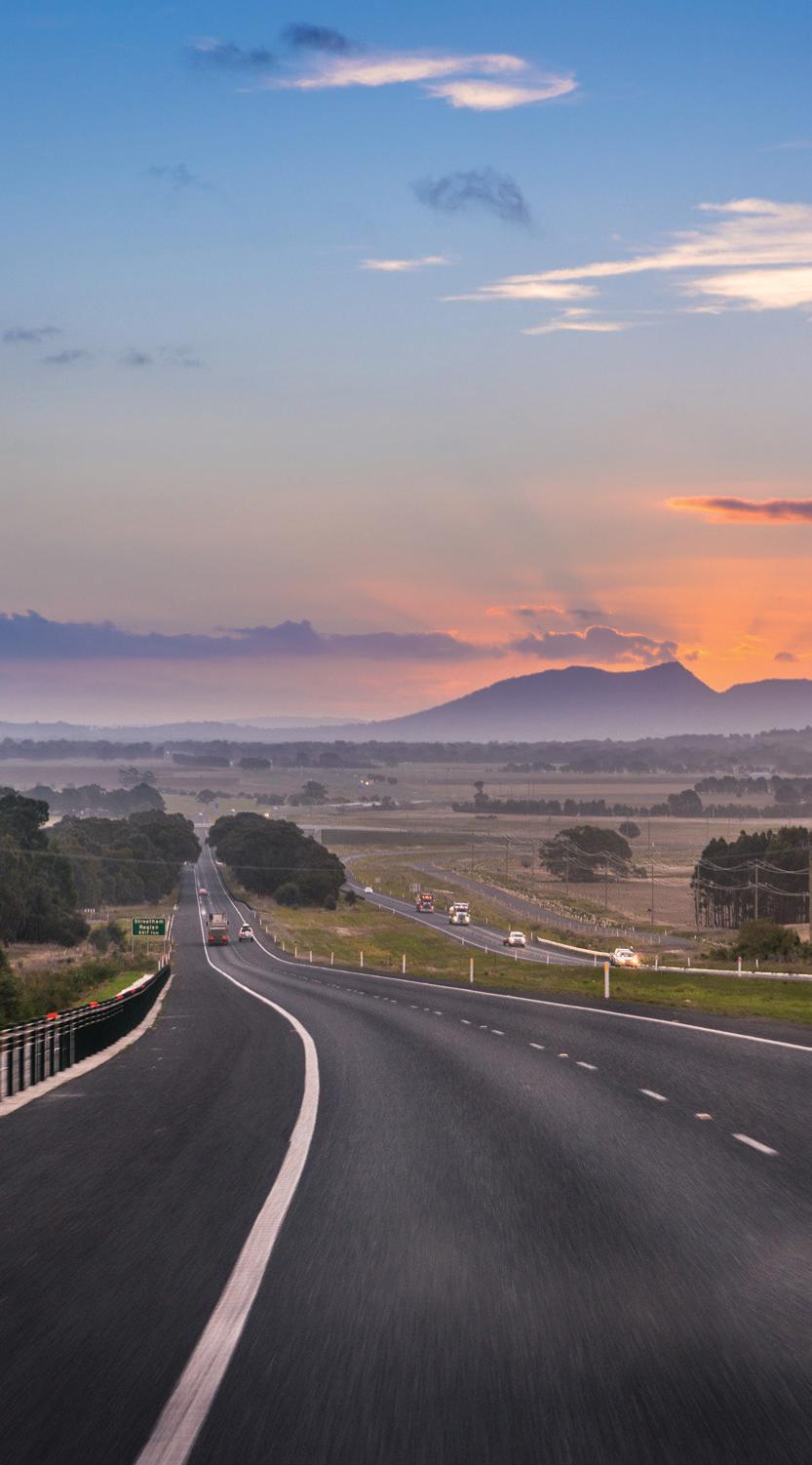
Barriers at the point of sale
Regardless of other limitations, electric vehicles are only accessible to buyers if car dealerships can facilitate sales. This relies on dealerships not only having stock and demo models, but having vehicles charged and ready to test drive and sales staff being knowledgeable and willing to provide answers to consumer questions.
While there is little data on dealerships’ commitment to selling EVs and having them available and ready to test drive, responses from consumers are varied, suggesting that Australian car dealers may not be ready, interested or equipped with the information necessary to deal with EV enquiries, creating a further barrier to sales in Australia.
Another barrier at the point of sale is the number of vehicles available on the Australian market. As of February 2020, the EV models available in Australia were:
» BMW i3 (2019)
» Hyundai Kona Electric (2019)
» Hyundai Ioniq Electric (2020)
» Nissan Leaf (2019)
» Renault Zoe (2019)
» Tesla Model 3 (2020)
While this range does offer potential EV buyers some choice, it’s a small range compared to countries such as the United States which have more than triple the range offered in Australia, and is no doubt a contributing factor to low uptake.
Lagging, but with solid potential
While Australia lags behind its global counterparts when it comes to EV uptake, the good news is, our potential for growth is strong.
Australians still love their personal cars, as our 2019 sales figures show, and we have a natural advantage when it comes to being able to generate the renewable energy to fuel these cars.
In good news for the sector, the Federal Government’s 2020-21 Budget pledged $74.5 million towards assisting businesses who are keen to look at cleaner vehicles, including hydrogen and electric vehicles, for their fleet requirements.
Uptake of EVs in Australia may currently be low, but the widespread adoption of EVs is a matter of when, not if. With rising consumer interest, and as these barriers continue to be addressed, Australia will start to move towards a more sustainable vehicle future.
www.energymagazine.com.au November 2020 ISSUE 12 ELECTRIC VEHICLES 47
3https://www.caradvice.com.au/829037/electric-car-charging-australia-challenges/
Range anxiety has traditionally been a concern for Australian drivers.
AUSTRALIA’S FIRST ELECTRIC-POWERED CHERRY PICKER HITS THE STREETS

Jemena and Zinfra expanded their Victorian fleet in August with the unveiling of an Australian-first electric-powered elevated work platform – colloquially known as a cherry picker – truck to perform upgrades and repairs on the Jemena Electricity Network in Melbourne’s north-west.
48 ELECTRIC VEHICLES
light
The truck has been performing street
repairs across the Jemena Electricity Network.
The fully electric elevated work platform (EWP) truck was launched as part of an effort to reduce carbon emissions across the Jemena Electricity Network, by reducing Jemena’s carbon output by 30 tonnes per year. This is in addition to other energy efficient initiatives already rolled out within the network, including the installation of 500 LED ‘smart street lights’ that use up to 75 per cent less energy than traditional lighting.
Jemena delivers electricity to more than 360,000 homes and businesses in Melbourne’s north-west, while Zinfra performs maintenance and operations services to the network. The electric EWP truck was a joint initiative for the companies, which are both owned by SGSP (Australia) Assets Pty Ltd.
Bringing the vehicle to life
Many businesses across Australia have already begun moving towards an electric vehicle fleet due to the savings that can be achieved on diesel, servicing and maintenance, as well as the significant benefit of lowering carbon emissions.
For energy companies that use larger vehicles, like EWPs, the process of moving towards an electric-powered fleet can be a bigger challenge.
For Jemena and Zinfra, bringing the electric EWP truck to life was a complex process that took over two years. The team knew many complexities would be involved, but after discussions with Australian automotive technology company SEA Electric and Victorian elevated work platform design and manufacturing company Nifty-Lift, the project started to take shape.
Nifty-Lift was engaged to customise their standard diesel-powered 16 metre elevating work platform truck so that it could be powered by the SEA Electric system.
“As a company that looks to make our elevated work platform range more operationally and environmentally efficient, we were thrilled to be involved in this industry-first project,” said Nifty-Lift Sales Manager Adam Youl.
“Our team of engineers worked with SEA Electric to ensure the integration of both systems would not impact the operational performance of the EWP, and the end result has exceeded our expectations. With the Nifty-Lift 180 degree fly boom, 350kg basket capacity and 12.3m of working side reach we see this NL160TF model as the most versatile and innovative insulated elevated work platform on the Australian market. Our team took great pride in being able to combine this technology with the

SEA Electric system to help produce the first of this next generation of elevated work platforms.”
SEA Electric converted the EWP truck into a 100 per cent electric vehicle equipped with a 138kWh battery pack that provides around 120km of range. The EWP is powered by the truck’s battery which is charged at the end of each day and takes around six hours to charge.
“It’s been a special and historical project for the management and engineering staff at SEA Electric to partner with Jemena in the development of this Australian-first 100 per cent electric elevated work platform service truck,” said SEA Electric Sales Director for Australia and New Zealand Joe Di Santo.
“The SEA Hino FG all-electric vehicle is anticipated to reduce Jemena’s carbon output by 30 tonnes per annum.”
Jemena’s Executive General Manager for Electricity Distribution Shaun Reardon said partnering with SEA Electric and Nifty-Lift was crucial to completing the vehicle to such a high standard.
“Building a customised EWP truck and then converting it into an electric vehicle was a major reconstruction that took place over two years,” said Mr Reardon. “SEA Electric and Nifty-Lift had the expertise and experience required to make this happen.”
Operating in the field
After Nifty-Lift and SEA Electric’s work was done, the truck arrived at Jemena’s Tullamarine Depot in early August with field crew members taking part in training shortly after. As well as learning how to drive the truck and operate the bucket, team members were trained on how and when to recharge the 138kWh battery pack.
“We were all impressed with how quiet the truck was when driving. It’s like driving a golf buggy – but a lot bigger!” said Zinfra Field Response Team Leader Martin Boddy.
“There was a lot of enthusiasm to learn how to use the new vehicle, and the team were interested in how long the battery would last. We have found operating the bucket uses very little battery life, while driving the truck uses the majority of the battery.
“At the end of each day the truck is connected to the charger at the Tullamarine Depot and it’s fully charged again by the next morning.“
Since it hit the streets in August, the truck has been performing street light repairs across the Jemena Electricity Network.
Benefits to customers
Not only will Jemena and Zinfra reap the environmental and financial rewards that come with operating an electric vehicle of this scale, there are also benefits to Jemena’s residential customers.
Compared to a diesel-powered truck, the electric-powered EWP truck is much quieter while both driving and operating the bucket. This means that residents not only have less noise in their neighbourhood, there are also zero exhaust fumes while repair and maintenance work is being performed.
“Reducing both noise and exhaust fumes within the neighbourhoods we operate in was a major drawcard for this vehicle,” said Mr Reardon.
What’s next
It’s been three months since the electric-powered EWP truck began operating in the field and so far, the field team have been impressed with its ease of operation and efficiency.
Over the coming months Jemena and Zinfra will continue to assess the operation and efficiency of the electric EWP truck as they look to make further energy efficiency improvements across the Jemena Electricity Network.
www.energymagazine.com.au November 2020 ISSUE 12 ELECTRIC VEHICLES 49
Jemena’s electric-powered Elevated Work Platform (EWP) truck.
ELECTRIC VEHICLE SUBSCRIPTIONS:
THE MODEL FOR THE FUTURE?
In Australia, ownership of electric vehicles is yet to take off like it has in other parts of the world. Could the answer to increasing the numbers of electric vehicles on the road lie in developing a subscription model to encourage drivers to enjoy the benefits these vehicles offer, without the hefty price tag?
AGL certainly thinks so; with the company recently launching its new electric vehicle (EV) subscription service through its innovation arm, AGL Next. In partnership with car subscription service Carbar and EV charging supplier JET Charge, this will be the first time an EV subscription service with these features has been offered in Australia.
AGL Executive General Manager Future Business & Technology, John Chambers, said AGL has created an innovative and flexible service to help customers drive towards a cleaner future, without the commitment of owning a car.
“As a leader in Australia’s energy market, AGL will use the best technologies to provide our customers with choice and flexibility, and this EV subscription service not only allows that, but puts them ahead of the curve,” Mr Chambers said.
“The market for EVs in Australia is continuing to grow, but we know many customers may still be reluctant to buy an EV outright due to price, concerns about technological change or access to charging facilities.
“AGL’s EV Subscription Service eliminates these concerns, allowing customers to access the latest technology as it hits the market.
“It’s a convenient option, with the latest EV model delivered to the customer’s home and at-home charging facilities installed, but with the flexibility to swap, upgrade or cancel the service at any time.
“We know customers are becoming more attuned with subscription services which provide all the benefits but none of the hassle – this is the Netflix of electric vehicles.”
As part of the AGL EV Subscription Service, customers will have access to electric vehicles from a range of leading

brands like Tesla, Jaguar, Hyundai and Nissan. The service will also include registration, insurance, tyres, repairs, roadside assistance and carbon neutral credits.
Mr Chambers said the market fundamentals supporting the uptake of EVs are strong.
“Over the next few years, more models will hit the market, prices will fall in line with petrol vehicles, and fast charging facilities will allow even greater distances to be travelled.
“Here at AGL we recently became the first Australian signatory to EV100, committing to making our own corporate fleet entirely EV by 2030.
“These changes will transform how Australia drives, and we anticipate that by 2030 half of all new cars sold could be electric.”
The AGL Electric Vehicle Subscription Service begins from $299 per week
November 2020 ISSUE 12 www.energymagazine.com.au 50 ELECTRIC VEHICLES
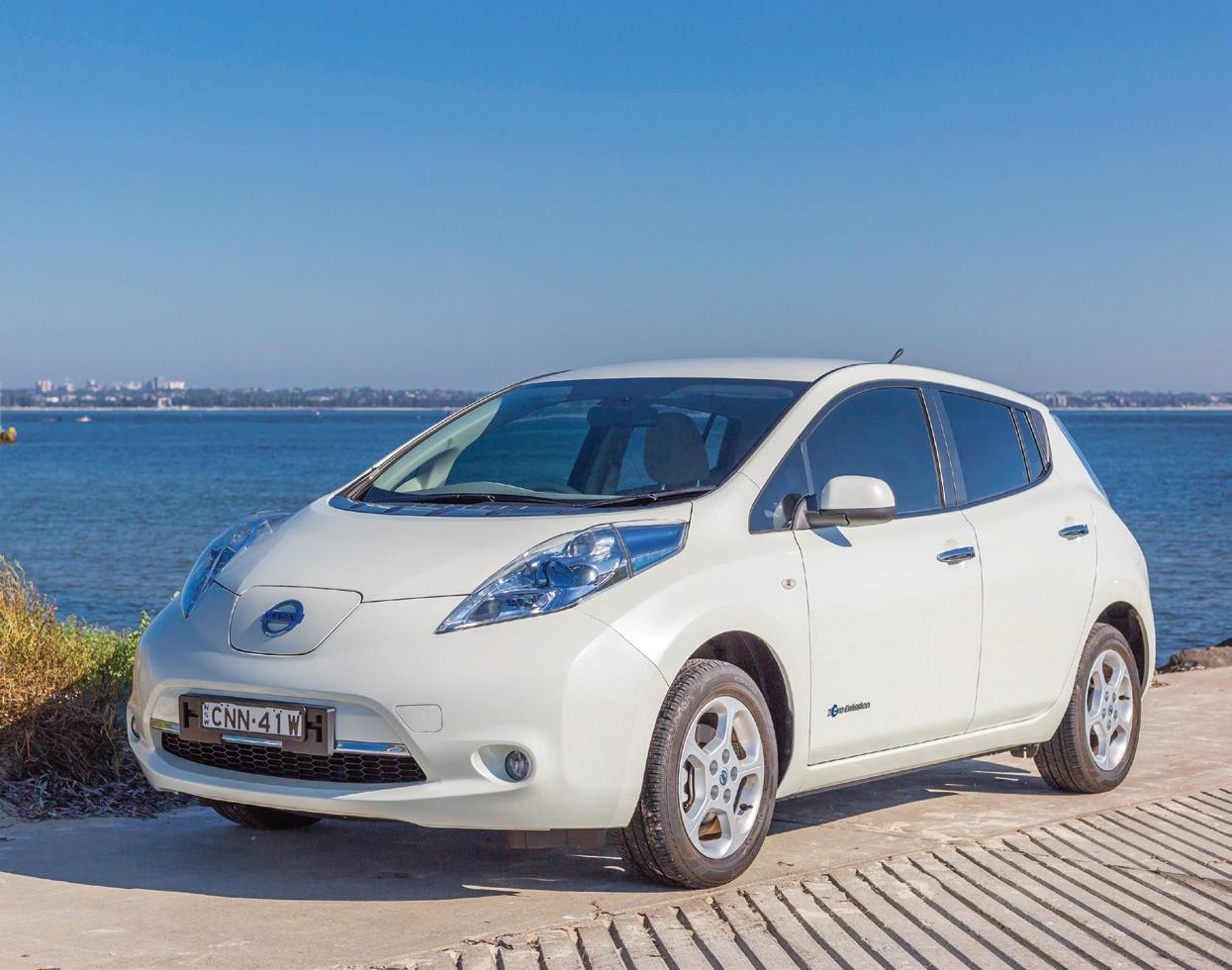
with no lock-in contracts. During the pilot phases, the service is only available to eligible customers within 50 kilometres of Sydney or Melbourne, but over time will be expanded and refined to ensure it meets the needs of more customers.
AGL’s customer-facing delivery team will practice COVID-safe, contactless delivery of vehicles. Unfortunately, due to government restrictions, orders for Victoria will be limited but customers will be put on a waitlist.
The EV Subscription Service will be delivered under AGL Next, an innovation initiative piloting new programs, technologies and partnerships across energy, telecommunications and beyond.
HOW THE SUBSCRIPTION WORKS
AGL’s flexible electric vehicle subscription allows users to enjoy the benefits of an electric vehicle, without the commitment of owning a car.
Drivers get the essentials
The fixed weekly payment covers the basics of driving an electric vehicle including the car, insurance and maintenance. AGL also manages the charging station.
Set up is covered
An AGL qualified electrician will set up a charger for use during the subscription period. When the car is ready, it’s delivered directly to the user’s door.
Get on the road
Once the vehicle has been delivered and the charger has been installed, each user is ready to go, driving towards a more sustainable future, without the commitment of owning an electric vehicle.
www.energymagazine.com.au November 2020 ISSUE 12 ELECTRIC VEHICLES 51
For more information, head to https://www.agl.com.au/get-connected/electric-vehicles
THE DEVELOPMENT APPROVALS PROCESS: POSITIONING YOUR PROJECT FOR SUCCESS

Before construction on a new energy project can begin, a well-planned development approvals process is critical.
52 DEVELOPMENTS

 by Natasha Reifschneider, Director, ESA2 Environment and Planning
by Natasha Reifschneider, Director, ESA2 Environment and Planning
Before any new energy development can begin, there is months of work that will go into ensuring that the project receives approval to commence. Here, we outline some of the key steps in the development approvals process, with tips to ensure you get each step right from the outset.
53 DEVELOPMENTS
Awell-planned development approvals process for any energy infrastructure project is critical. Much of the application detail has to do with the technical components of the technology proposed, however the ‘non-technical’ project manager or director has a key role to ensure the project proposal has every chance for success. This is particularly important where the regulator is a council or government department that may have limited knowledge of the project.
Selecting the right consultant for your team, making sure your proposal is well developed, and engaging with regulators who will be assessing your application are just some of the key actions that will set your project up for success.
In this article, we take a closer look at the top tips that will set you up for success during the approvals process.
A well-developed application
Project development managers are often working to a tight timeline and budget, which pushes them to compress the upfront time for development of the proposal information and push through a submission to the regulators.
Here are a couple of tips to make sure your application is ready for submission:
» Allow enough time for project development – a well thought-out proposal with clear elements which are committed before you formally submit your application will save your project time and money. If you enter the Development Application phase of the project with missing information, it’s likely to come across to the regulator and raise unnecessary attention. Reworking of projects cost time and money, and can result in a loss of momentum in the project team, and may put the community offside. It is worth spending more time and energy on specific detail before you launch into submission.
» Take out the tech – complex projects have an element of tech talk, however Development Planners in council and state government are not engineers and do not need to know the mechanics of every piece of plant equipment. Diagrams and language in your development application should be simple and easy to understand. Use plain language to keep the audience interested in the project layout and impacts. Keep the tech in the appendix of the report unless it is required upfront. Development applications are often advertised to the wider community who need to understand the project and purpose to respond in a meaningful way.
Engage with the regulators
Engaging face-to-face with regulators builds trust and sets your project up on a solid platform for clear communication. Here are some tips for successful engagement:
» Understand regulator roles – large infrastructure projects with several legislative approvals will attract many public servants. It is helpful to map out the individuals at each government department you will be dealing with during the life of your application to develop a clear understanding of:
» Their role and responsibility on your project
» Limits of their roles – what decisions are outside of their control?
» How they want to communicate throughout the project
» Who they directly report to
» Other projects they are assessing, and where your project falls in this priority list
» Engage early – when your application is in its infancy, start engaging with the regulator. It’s never too early to engage,
as it demonstrates your openness about the project and desire to receive feedback to achieve a positive end result. Once you have worked through key project details with your team, such as the location and general design, it’s worth considering a pre-application meeting to introduce the project formally to the regulator, to work through legislative and application requirements, potential red flags, and to develop a relationship. Take the regulator on a site visit to show them the site you are considering for the proposal and give them the opportunity to provide a preliminary response before you lock in all elements of your project design.
» Community Engagement Plan – during your early engagement with the regulator, consider providing a copy of your Community Engagement Plan which sets out how and when you intend to engage with the community and key stakeholders. Providing this plan early will allow the regulator to provide input into the engagement strategy and ensure you have identified all stakeholders groups that require consultation. Your engagement plan should define negotiables and non-negotiables, set out when and how you will engage and allow for ongoing refinements of the Engagement Plan.
The right consultant team
It is critical to engage the right consultant to prepare your development application. You want a consultant team you can trust, has appropriate experience, knowledge, and communication skills.
Key skills to look for include:
» Industry experience – selecting a lead consultant that has project experience which is directly relevant to your project is vital to its success. A development planner with 20 years of experience in the residential sector is likely to be out of their depth on an industrial project such as a major wind farm. It is the experience of the lead consultant that is important, as they lead the team and the process. Engaging a lead consultant that has successfully delivered a project like yours will greatly benefit the project.
» Local experience – choosing a consultant team that has state-based experience is key. They will know the legislation, the locality of your project, understand the regulator and can provide important past learnings of projects in the locality. Local knowledge will also allow the team to hit the ground running as they will have some knowledge of the site, issues and community expectations before they commence the project.
» Effort – understand the offer the consultant is making in their proposal. Is the lead consultant engaging regulators and driving the project and communicating with the client, or is it the junior consultant? If you have an expectation that you will be working with the lead consultant directly, you need to make sure this is clear in the consultant offer. It is totally appropriate to request a breakdown of hours and rates for each consultant to provide this information.
» Relationship – hire a consultant who has a good working reputation with the regulator. The services of a consultant who has an established relationship with the regulators can reduce the likelihood for project delay. The consultant is likely to have a clear understanding of the regulator requirements and address them at the outset, saving the project time and money. The project manager and project director also need to ensure they can maintain a positive relationship with the consultant they select. Your project may take many months to work through, and you need to be able to work with the preferred consultants all the way through the project life-cycle.
54 November 2020 ISSUE 12 www.energymagazine.com.au DEVELOPMENTS

A positive working relationship with all members of the development approvals team is critical.
55 www.energymagazine.com.au November 2020 ISSUE 12 DEVELOPMENTS

HARNESSING THE POWER OF BIOSOLIDS TO MAKE HYDROGEN
Hydrogen is being hailed as having the power to accelerate the global transition to renewable energy. In an exciting new development, researchers have now used biosolids to produce hydrogen from wastewater, in new technology that supports the comprehensive recycling of one of humanity’s unlimited resources – sewage.
November 2020 ISSUE 12 www.energymagazine.com.au 56 BIOFUELS
The innovation focuses on the advanced upcycling of biosolids and biogas, by-products of the wastewater treatment process.
Developed by researchers at RMIT University, the patented technology uses a special material derived from biosolids to spark chemical reactions for producing hydrogen from biogas.
The approach means all the materials needed for hydrogen production could be sourced on-site at a wastewater treatment plant, without the need for expensive catalysts.
The method also traps the carbon found in biosolids and biogas, which could in future enable a near zero-emission wastewater sector.
Lead researcher Associate Professor Kalpit Shah said existing commercial methods for producing hydrogen were emission and capitalintensive, and relied heavily on natural gas.
“Our alternative technology offers a sustainable, cost-effective, renewable and efficient approach to hydrogen production,” said Associate Professor Shah, Deputy Director (Academic) of the ARC Training Centre for Transformation of Australia’s Biosolids Resource at RMIT.

“To enable the transition to a circular economy, we need technology that enables us to squeeze the full value from resources that would ordinarily go to waste.
“Our new technology for making hydrogen relies on waste materials that are essentially in unlimited supply.
“By harnessing the power of biosolids to produce a fully clean fuel from biogas – while simultaneously preventing greenhouse gas emissions – we can deliver a true environmental and economic win.”
Biosolids are commonly used as fertiliser and soil amendment in agriculture, but around 30 per cent of the world’s biosolids resource is stockpiled or sent to landfill, creating an environmental challenge.
Dr Aravind Surapaneni, Senior Research and Planning Scientist at South East Water and Deputy Director (Industry) of the ARC Training Centre for Transformation of Australia’s Biosolids Resource, said research into new and valuable uses for biosolids was vital.
“The wastewater sector is constantly looking to develop new ways to transform biosolids into high-value products in environmentally sustainable and responsible ways,” Dr Surapaneni said.
www.energymagazine.com.au November 2020 ISSUE 12 BIOFUELS 57

How the tech works
In the new method, published in the International Journal of Hydrogen Energy, biosolids are first converted to biochar – a carbon-rich form of charcoal used to improve soil health.
The biosolids-derived biochar contains some heavy metals, which makes it an ideal catalyst for producing hydrogen out of biogas.
As part of the experimental bench-scale study, researchers tested the process with a methane-rich gas that resembles biogas.
They showed the biochar made from biosolids is highly effective for decomposing the gas into its component elements – hydrogen and carbon.
The decomposition process can also be conducted in a specially-designed and hyper-efficient reactor developed and patented by RMIT, which can produce both hydrogen and a high-value biochar that is coated with carbon nanomaterials.
By converting the carbon found in biogas and biosolids into advanced carbon nanomaterials, their method can also
capture and sequester the greenhouse gas to prevent its release into the atmosphere.
The carbon nanomaterial-coated biochar produced through the novel technique has a range of potential applications including environmental remediation, boosting agricultural soils and energy storage.
Patented reactor technology
Associate Professor Shah said the unique reactor developed by the RMIT School of Engineering team was at the heart of this innovative recycling approach.
“We’ve radically optimised heat and mass transfer in our reactor, while shrinking the technology to make it highly mobile,” he said.
“There are no reactors available that can achieve such phenomenal heat and mass integration in such a small and costeffective package.
“And while it’s already energy efficient, with further integration, this reactor could turn biosolids and biogas conversion into a process that actually produces energy instead of consuming it.”
As well as being used in wastewater treatment, the novel reactor has potential applications in the biomass, plastics and coating industries.
The research was supported by South East Water, which will be trialling the biosolids and biogas conversion technology in a pilot plant currently under fabrication.
Dr David Bergmann, Research and Development Manager at South East Water, said the technology had potential for adoption by the industry.
“Supporting these kinds of innovative emerging technologies is an important part of our commitment towards reduced emissions and a circular economy approach involving wastewater,” Dr Bergmann said.
The Australian Research Council Training Centre for Transformation of Australia’s Biosolids Resource based at RMIT brings together expertise from 20 national and international partners from Australia, the UK and US including universities, wastewater sector and allied industry partners.
November 2020 ISSUE 12 www.energymagazine.com.au 58 BIOFUELS
Lead researcher Associate Professor Kalpit Shah, with the novel reactor developed and patented by RMIT University.

TOMORROW’S SOLUTIONS. TODAY
A PROACTIVE APPROACH
TO MA NAGING LARGE ENERGY DEMANDS
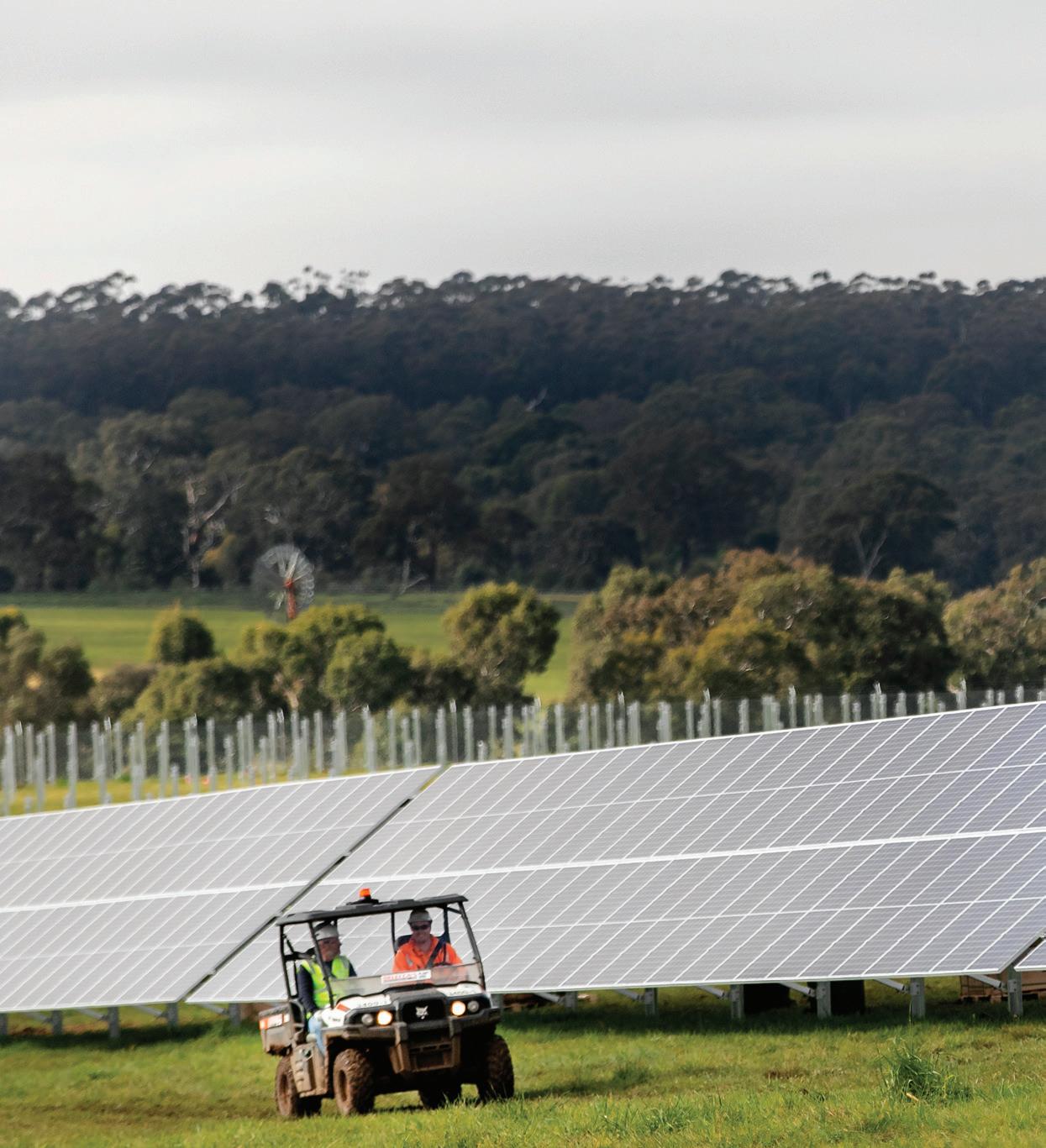
Melbourne Airport is one of the country’s biggest users of energy, and the facility has taken a proactive approach to sourcing and managing its energy needs beyond 2020.
November 2020 ISSUE 12 www.energymagazine.com.au 60 DEMAND MANAGEMENT
Melbourne Airport’s electricity demand is forecast to grow significantly over the next five years, driven by terminal and airfield development. Historically, growth of such magnitude has resulted in a significant increase in energy requirements – and as a by-product, the increased consumption of fossil fuel resources.
This increased consumption has both local and global risk implications for the airport’s environment and heritage. Recognising these risks, Melbourne Airport is taking action by investing in renewable energy, building a new solar farm on the airfield to meet its increased energy needs.
The solar farm will have the capability to produce enough renewable energy to power all four passenger terminals when it is turned on in January 2021. The project is the largest of its kind in Australia.
The solar farm will see Melbourne Airport generating 17GW hours of electricity per annum, which is equal to nearly 15 per cent of the airport’s annual electricity consumption.
Construction of the solar farm is well advanced; with all panels now installed. The panels were installed at a site off Sunbury Road, which was chosen as a location due to the available land, proximity to the airport and the maximum direct sunlight without obstructions – optimal for producing solar energy.
Melbourne Airport Chief of Landside Access Lorie Argus said she was proud of the investment in renewable energy, which will reduce the airport’s carbon footprint.
“With the airport’s electricity demand expected to grow, the construction of our solar farm makes sense for several reasons,” said Mrs Argus.
“The project is expected to deliver significant annualised energy cost savings, a timely benefit with the impacts of COVID-19 wreaking havoc on the aviation industry.
“Additionally, we are committed to growing the airport in an environmentally, socially and economically sustainable way. This renewable energy project is another chapter in that story.”
Beon Energy Solutions General Manager Glen Thomson said the company is excited to be working with Melbourne Airport to deliver Australia's largest behind-the-meter solar installation – the largest of any airport in the country.
“The airport location brings with it some unique complexities and challenges, which utilises our collective strengths,” Mr Thomson said.
“We congratulate Melbourne Airport on their investment and focus on innovative solutions to their growing energy needs, and we look forward to continuing the relationship with similar projects across the airport precinct.”
In addition to working with Beon Energy Solutions for the development of the solar farm, Melbourne Airport has also enlisted the services
of SMA Australia, who provided the containerised inverter modules, and Canadian Solar, who provided the solar panels.
Multiple benefits for a large energy user
For Melbourne Airport, the decision to proceed with this development was largely about investing in renewable energy to reduce the airport’s carbon footprint. The annual cost savings the airport will see as a large energy user added to the attractiveness of the development.
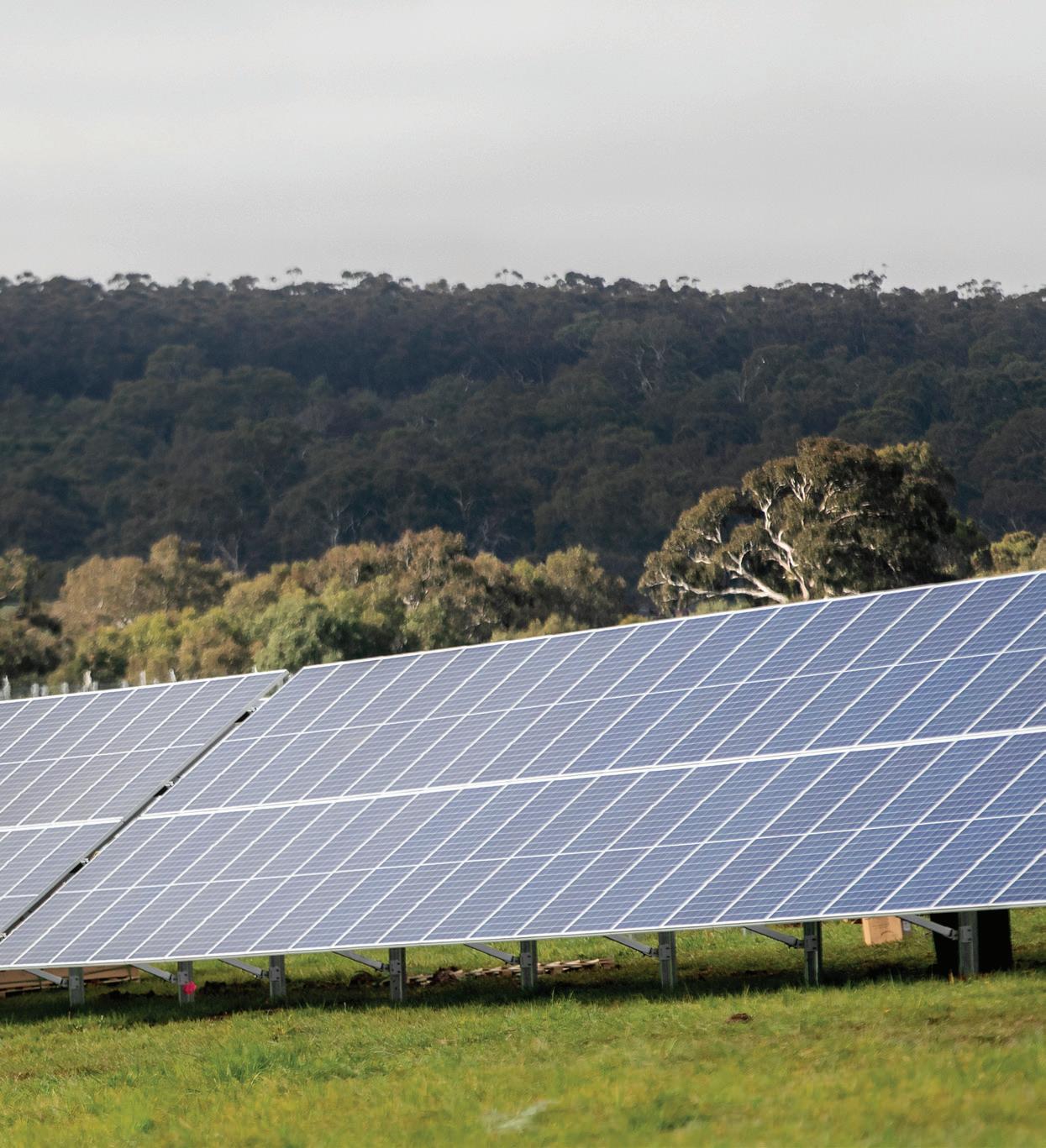
The solar farm, which is the length of approximately 26 soccer fields, is one of the largest behind-the-metre solar farms in the Southern Hemisphere – the site itself is 192,000 square metres.
“Having our own solar farm means that environmentally, we are growing the airport in a sustainable way and are also able to deliver energy cost savings,” said Mrs Argus.
“Since construction commenced, we’ve been contacted by Melbourne Markets, Latrobe University and a few other large organisations wanting to find out more about how they can implement similar solar initiatives. It’s been great to be able to share our knowledge and first-hand experience.”
Key learnings from the project included:
» Mitigating the effect of reflected glare from solar panels on planes: this can be managed through an aviation impact assessment, using the latest software modelling to confirm there is no impact to pilot safety. Melbourne Airport chose a fixed ground racking system for the solar panels, in lieu of a tracking system, to assist in managing these risks.
» Bird roosting: this can be an issue around the airport approaches. However, all plants around the development have been chosen to minimise any bird roosting risks. For example, shrubs have been chosen to be planted around the perimeter.
A focus on sustainability
In addition to the new solar farm, Melbourne Airport has a number of other initiatives in place that enhance its sustainability and energy self-sufficiency credentials.
It also has an 8MW trigeneration plant that provides power into the airport’s high voltage network. Both the solar farm and the trigeneration plant can operate in unison due to the fact that the airport’s load is more than the sum of what the solar farm and trigeneration plant can produce.
Melbourne Airport has also installed a solar array on the rooftop of one of its tenant’s warehouses, located in the Melbourne Airport Business Park. The 2MW capacity array, perched on Agility’s roof, is approximately 30,000 square metres and is the airport’s first solar development on a roof structure. The system will connect into Melbourne Airport’s embedded network.
www.energymagazine.com.au November 2020 ISSUE 12 DEMAND MANAGEMENT 61
SA POWER NETWORKS WINS 2020
INDUSTRY INNOVATION AWARD
Energy Networks Australia has announced SA Power Networks as the winner of the 2020 Industry Innovation Award.
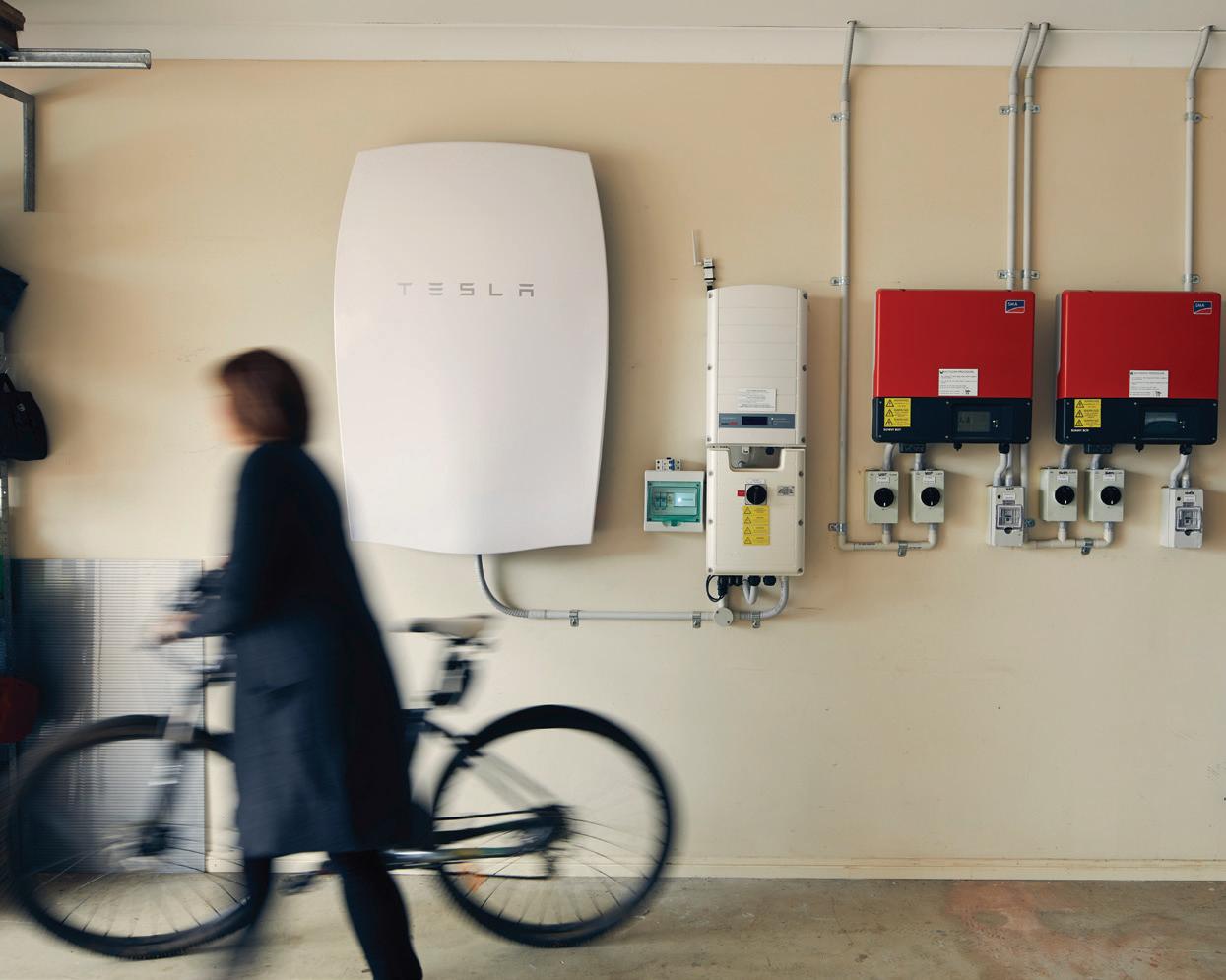
62 November 2020 ISSUE 12 www.energymagazine.com.au INDUSTRY NEWS ENERGY PARTNER CONTENT
SA Power Networks won the ENA Innovation Award for their South Australian VPP.
Presented for SA Power Networks’ Advanced Virtual Power Plant (VPP) Grid Integration Trial, the award recognises the distribution network’s national leadership in the design and application of groundbreaking technology supporting Australia’s customer-focused energy transition.
VPPs aggregate large numbers of customer batteries to operate in much the same way as a traditional power station. SA Power Networks worked with Tesla on its South Australian VPP to develop and demonstrate how real-time integration between networks and VPPs can maximise the benefits – economic and environmental – for all customers, VPP operators and network managers in the National Electricity Market.
The project has shown how higher levels of energy exports to the grid from customer systems can be enabled through flexible, rather than fixed, export limits. It tested the value this can create for VPP operators, who also have the opportunity to provide important network support services such as frequency control.
When fully deployed to up to 50,000 households, the SA VPP’s power output will be able to be doubled compared with traditional approaches to grid integration, increasing its export capacity to 500 MW – the same capacity as the now decommissioned coal-fired Port Augusta (Northern) Power Station – and supporting up to one-third of typical state electricity demand.
This project is believed to be the first to demonstrate this concept in actual operation with the largest VPP actively participating in the Australian energy market, and to seek to measure the realworld costs and benefits of this approach.
Energy Networks Australia CEO, Andrew Dillon, said the project demonstrated SA Power Networks’ understanding of the immense change the energy sector was undergoing and the economic and social need to create smarter energy grids.
“The VPP Grid Integration Trial is a fine example of energy network innovation
facilitating the renewable energy transition while enhancing the safety, reliability and affordability of electricity,” Mr Dillon said.
“This is an important project not just for South Australia but for the nation as we work to integrate increasing amounts of distributed energy into the electricity system.
“The learnings from this ambitious project will contribute to the development of smarter grids and better customer outcomes across the country.”
Accepting the award on behalf of SA Power Networks, Mark Vincent, GM Strategy & Transformation, said the concept was simple. “Instead of fixed export limits, we have created the capacity to provide flexible export limits that maximise the opportunity for everyone to share the energy generated from their rooftops,” he said.
“Our next step is developing a flexible exports option for individual customers to maximise their export capacity as well as the groups of customers managed within VPPs. We are aiming to make this wider offering available to all solar customers in South Australia in 2022.
“This delivers a step change in terms of integrating renewables with the grid, and we anticipate the work we are doing is creating the blueprint for a national approach to integration of DER. Our approach has the support of the solar industry, equipment manufacturers, networks, system managers and policy makers.”
There were eleven nominations in total for this year’s award, and Energy Networks Australia congratulates nominees for the extremely high standard of the eleven entries.
There were four finalists for the award –in addition to SA Power Networks, Energy Queensland, Transgrid and Western Power were all named finalists for the award.
Energy Queensland – Smart solar export in real-time via Dynamic Operating Envelopes
The Cleveland Solar Dynamic Operating Envelope (DOE) Trial successfully demonstrated the innovative application of available cost-effective technologies to implement a DOE that efficiently manages
surplus energy exported to the network from a commercial-scale 50kVA solar photovoltaic system.
The industry-leading DOE encompasses a range of allowable export values which the local network can accommodate based on real-time network conditions. Today, a comparatively small upfront cost can unlock added revenue for customers through export. Tomorrow this intelligence may enable customers to participate in energy markets, directly or through an aggregator, using their system to reap additional economic benefits.
Transgrid – Unmanned aircraft (drone) powerline stringing program
TransGrid has partnered with Infravision to develop a drone powerline stringing program. Infravision is a drone technology company specialising in solutions for the transmission industry, to develop a safer method to conduct aerial transmission line stringing using heavy-lift drones.
As a result of the engagement, Infravision developed a connected hardware system using drones and networked smart winches to provide a safer, more cost-effective and more customer-focused method for powerline stringing in the transmission industry.
Western Power – Autonomous Grid modelling and solution
Western Power has developed a longterm modelling and planning capability, referred to as the Grid Transformation Engine, that considers a range of energy supply and demand scenarios to enable us to take tangible steps toward a future grid vision that will fundamentally change the network of today.
This has seen Western Power deliver 52 stand-alone power systems in 2020 with a further 100 units planned for 2021. As a world leader in using this technology, Western Power is making significant headway in improving power reliability and network efficiency; and delivering a lower carbon energy future for Western Australians.

www.energymagazine.com.au November 2020 ISSUE 12 ENERGY PARTNER CONTENT INDUSTRY NEWS
63
The VPP is demonstrating how real-time integration between networks and VPPs can maximise environment and economic benefits.
64 November 2020 ISSUE 12 www.energymagazine.com.au MAJOR FEATURES Grid integration and stabilisation Disruption Embedded networks Biofuels SPECIAL FOCUS Electric vehicles IoT & cloud communication Demand management EQUIPMENT & MACHINERY Switchgear November 2021 Deadline: 15 October 2021 FEATURES SCHEDULE
activ8me ........................................................................................................................................................................... IFC AGC Plastics ........................................................................................................................................................................ 13 Energy Networks Australia IBC Monkey Media .................................................................................................................................................................... 41 OMICRON Electronics 39 Preformed Line Products ..................................................................................................................................................... 40 Resourceco 59 SATEC Australia .................................................................................................................................................................... 9 Vermeer OBC WINconnect ........................................................................................................................................................................ 21 ADVERTISERS’ INDEX MAJOR FEATURES Solar Domestic gas outlook Hydrogen and future fuels SPECIAL FOCUS Smart networks (big data, smart meters and smart grids) Consumer and industrial retail Security EQUIPMENT & MACHINERY Spatial & GIS MAJOR FEATURES Energy networks Storage and solar Safety and risk management Waste-to-energy SPECIAL FOCUS Automation Asset management Industrial energy EQUIPMENT & MACHINERY Transformers and substations Vegetation management June 2021 Deadline: 23 April 2021 MAJOR FEATURES Wind Nuclear energy Gas pipelines Energy efficiency SPECIAL FOCUS Microgrids Disaster management Distributed generation EQUIPMENT & MACHINERY Asset inspection & drones/UAVs September 2021 Deadline: 23 July 2021 March 2021 Deadline: 22 January 2021
FEATURES SCHEDULE
Brisbane Convention & Exhibition Centre
Exhibition and sponsorship opportunities available and selling fast
Go to www.en2021.com.au to find out how you can get involved
early bird closes 172021August Register now
www.EN2021.com.au
RESEARCH PARTNER PRINCIPAL SPONSOR

THE COMPACT ROCK DRILL TO CONQUER ALL TERRAIN
The D23x30DR S3 Navigator® offers the latest dual rod technology in a narrow (141cm) yet powerful machine that enables operators to confidently and efficiently move through rock on tight jobsites. It continues the legacy of the S3 badge - Speed, Simplicity and Sound - and adds rock capability, plus multiple rod options. LEARN MORE AT VERMEERAUSTRALIA.COM.AU
Australia
REDEFINED THE NEW D23X30DR S3 ROCK DRILL
Vermeer and the Vermeer logo are trademarks of Vermeer Manufacturing Company in the United States and /or other countries. © 2020 RDO Equipment Pty Ltd (trading as Vermeer Australia). All Rights Reserved. Overseas model shown.
/ VermeerAustralia VERMEERAUSTRALIA.COM.AU | 1300 VERMEER






























































































 by Natasha Reifschneider, Director, ESA2 Environment and Planning
by Natasha Reifschneider, Director, ESA2 Environment and Planning









